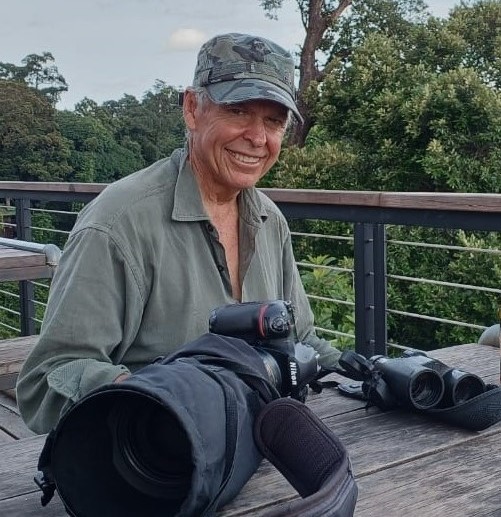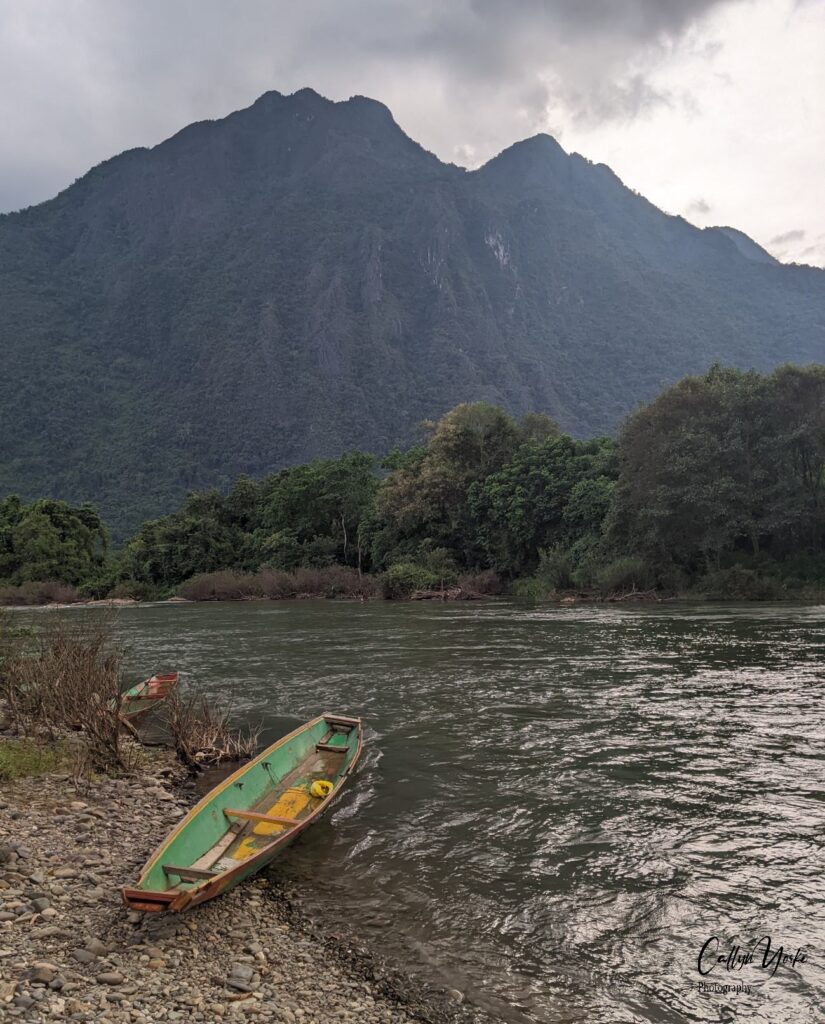
Laos Trip Report July 26 – August 11, 2022 Callyn Yorke
(Scroll down for Annotated Bird Lists)
INTRODUCTION
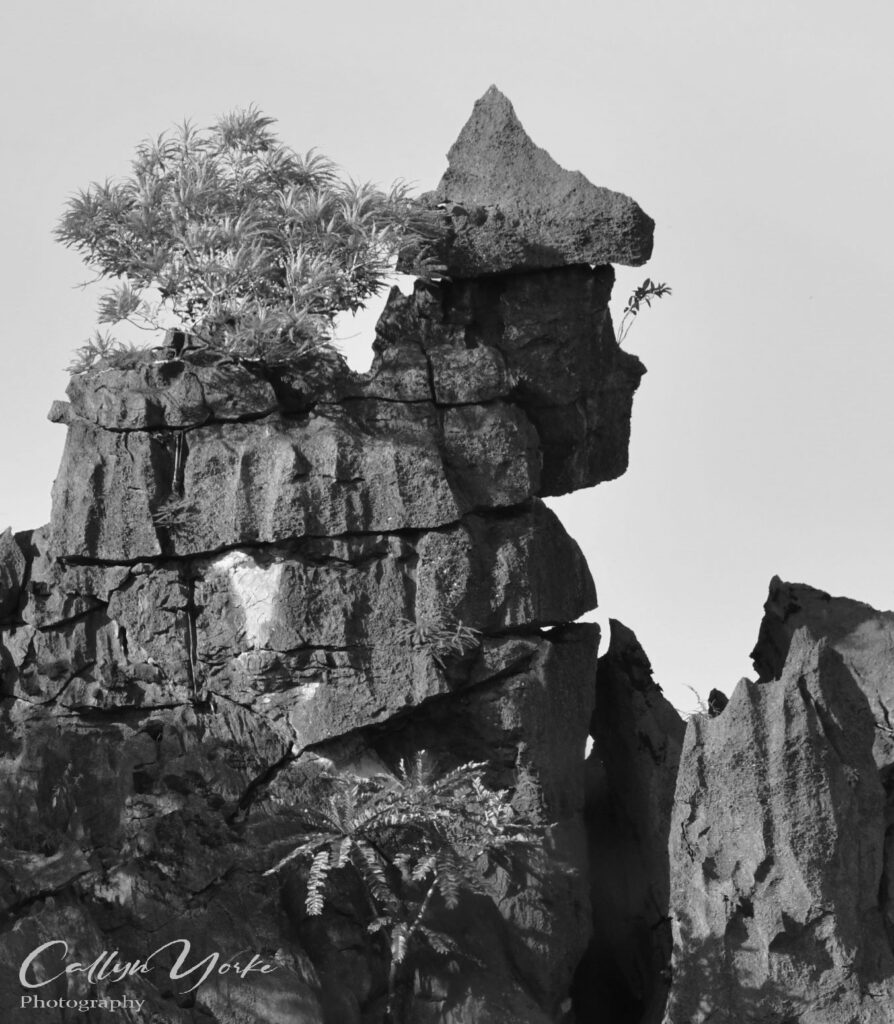
Laos, a comparatively small, landlocked nation of 7.3 million people in Southeast Asia, is a country of mixed blessings. Everywhere is splendid mountain scenery and in some areas extremely rugged karst topography supporting largely unexplored rainforests; there are towering waterfalls and legendary rivers, bucolic pastures and rice paddy fields greener than a treasure-dragon’s eyes.
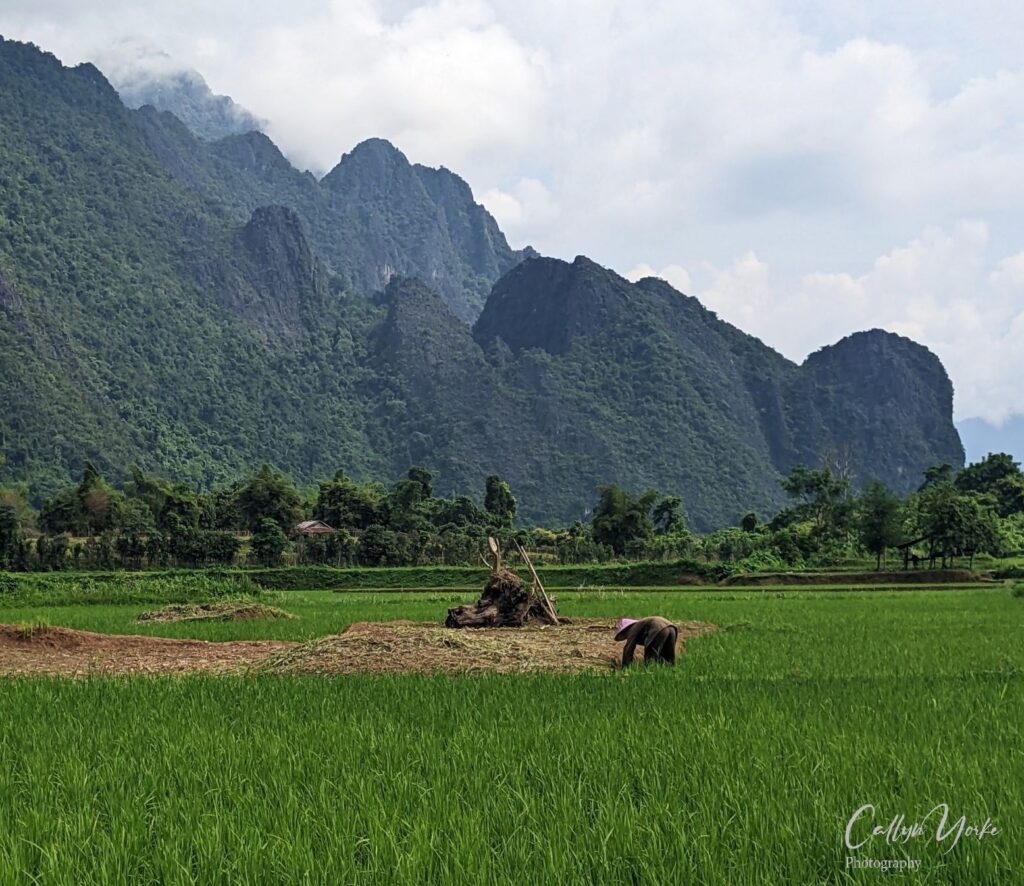
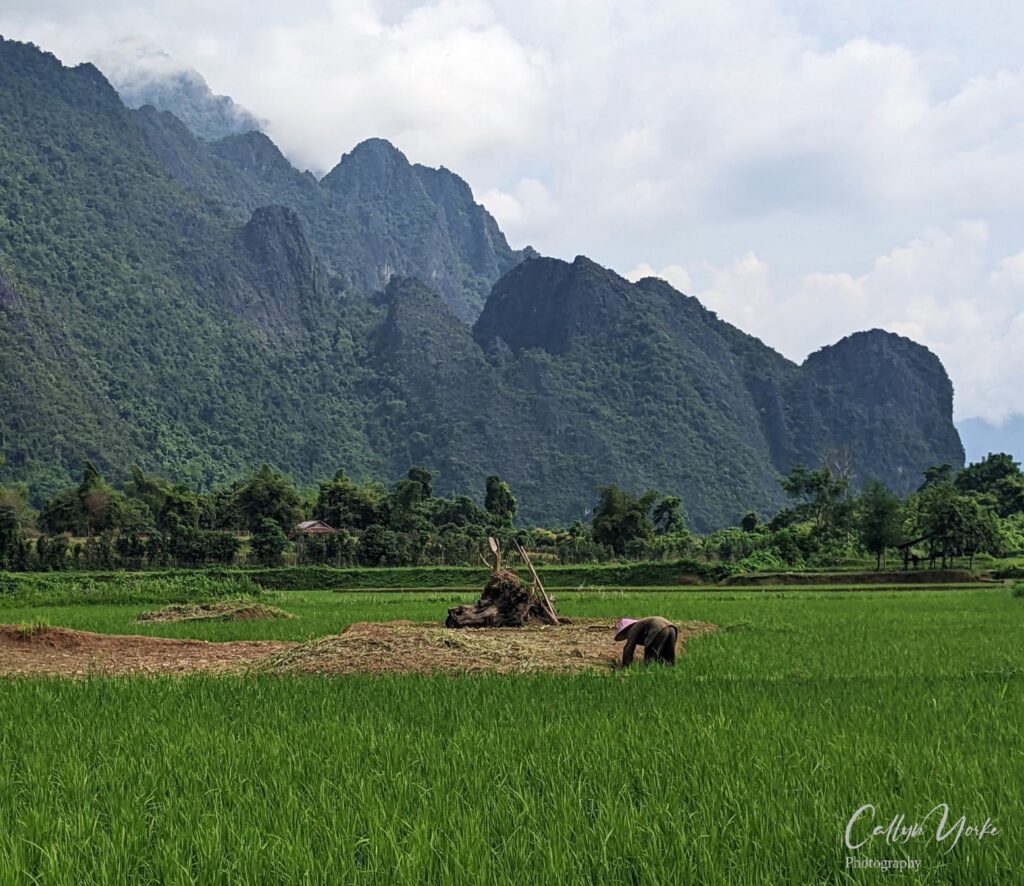
Laos is a bountiful harvest for National Geographic-style photography. At first glance, the country is quintessential Oriental enchantment, with a rich, ancient culture and for most Westerners, a language as impenetrable as the jagged limestone blades of the Na Hin mountains.
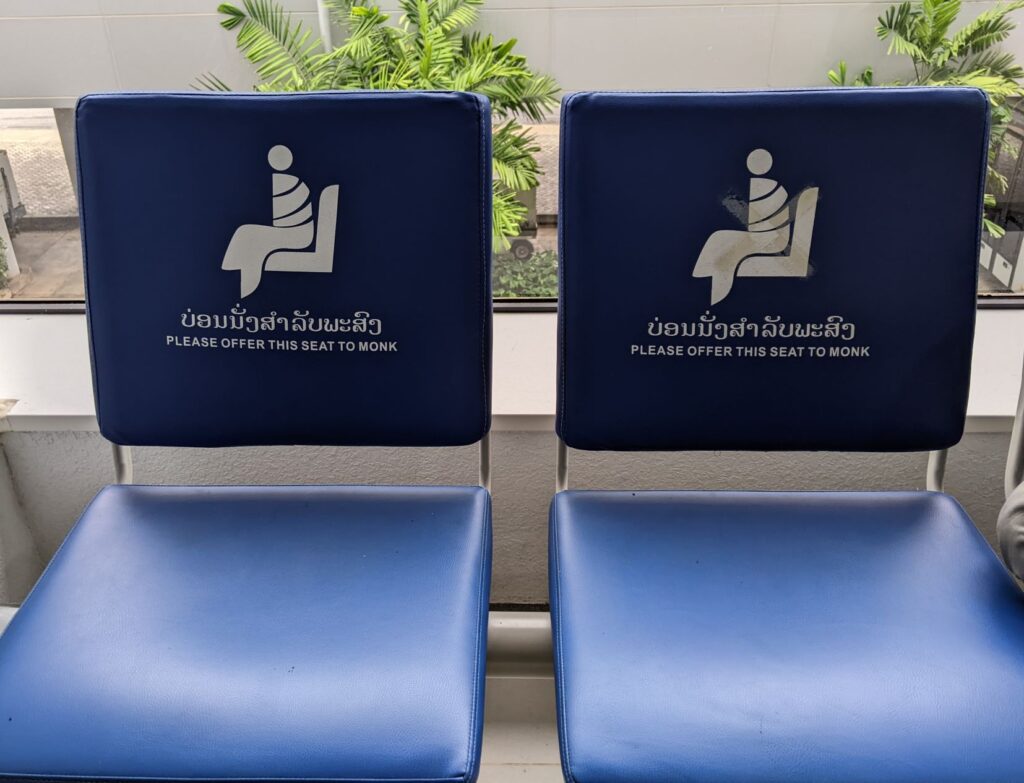
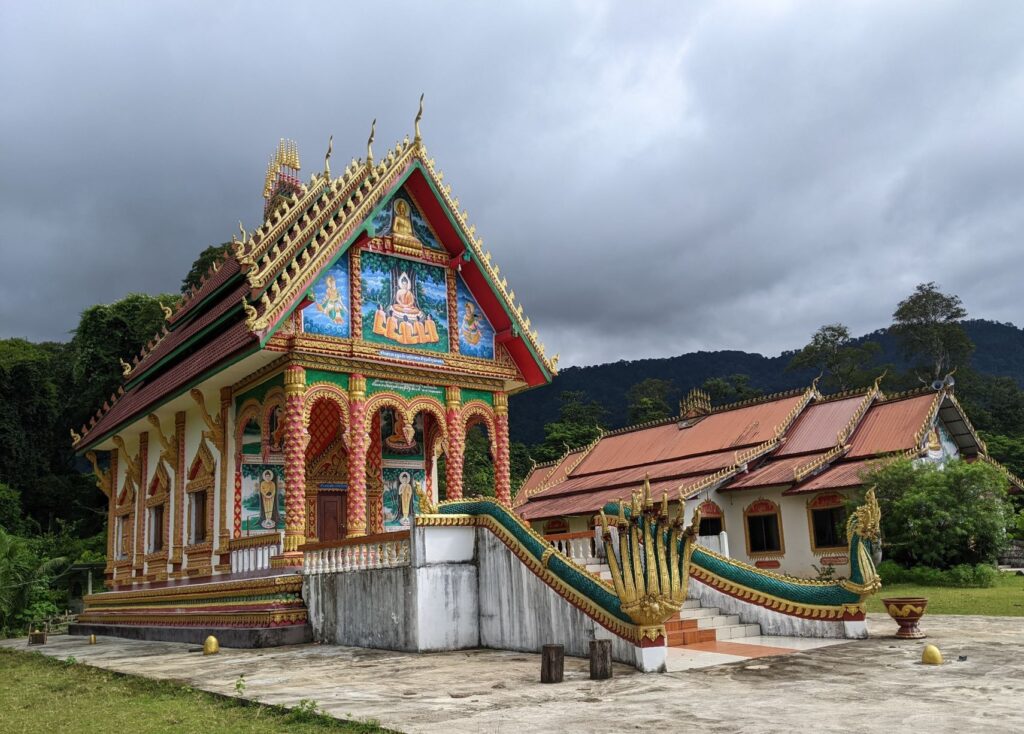
Those features alone, combined with favorable foreign currency exchange rates and affordable accommodation, should be enough to enthrall any world traveler and place Laos high on their list of favorite destinations.
Disappointingly, more than a few characters are missing from the Laos natural history scene. That certainly was my impression in Laos after spending two weeks in the field with a keen interest in wildlife photography, particularly of birds. Even in some of the most pristine areas, for example, the Song River in Vangvieng, I seldom encountered more than fifteen species of bird during a single survey.

In that regard, Laos is decidedly impoverished. Comparable field surveys in neighboring countries of Thailand, Cambodia and Vietnam, covering the same variety of habitats in two weeks during the summer monsoon season, would have likely produced a bird list of around two-hundred species. I considered myself lucky to have found and identified only about half that number of species in Laos. Most of the larger species (e.g. > 30 g), including waterbirds (e.g. rails, herons, egrets), were conspicuously absent from my survey areas. The few remaining bird species tended to be gregarious, opportunistic commensals, occurring throughout Southeast Asia.
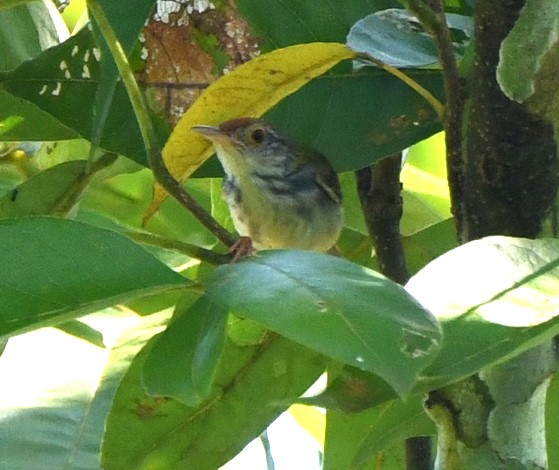
There is, however, hopeful, if not down-right exciting news for naturalists visiting Laos. Hanging on in the formidable karst knife-blade rainforests near Na Hin, are some remarkable animals, endemic to Laos and eagerly sought after by international birders and mammal-watchers. Among those, were two species I was fortunate to see and photograph, the newly described Bare-faced Bulbul (Pycnonotus hualon) and Laotian Langur (Trachypithecus laotum). Other, near-endemic species I encountered in this area included, Sooty Babbler (Stachyris herberti) – also found sparingly in Vietnam (see Na Hin – Annotated Bird List).
One of the most interesting of Southeast Asian mammals recently described by Western scientists, is the Laotian Rock Rat (Laonastes aenigmamus). This curious little beast, looking like part rat and part squirrel, is apparently the sole survivor of an otherwise long extinct family of rodents (Diatomyidae). If I managed a photograph of that little trophy animal, my mammal-listing colleagues would probably stop talking with me. Indeed, finding and photographing the endemic birds and mammals of Laos was one of my main objectives of this trip. And with help from my good friend, Le Quy Minh, I ended up with three out of the four, missing only the enigmatic Laos Rock Rat (locals said it might be easier to find in the dry season).
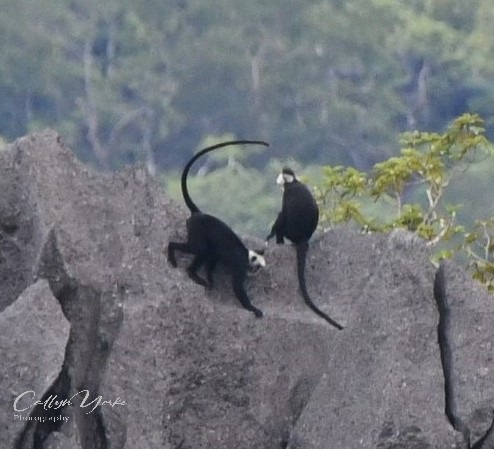
The most obvious and pressing question I had during the visit was: What has happened to the once abundant and diversified wildlife of Laos? The short answer is, “It’s largely gone; or perhaps gone into hiding.” Everything from grasshoppers to monkeys has been snatched, snared, trapped, mist-netted, shot and dismembered by Laotians with great consumptive enthusiasm. Practically nothing edible is sacred or taboo in Laos (c.f. India & Thailand). I’m guessing that unemployment and idleness among villagers during the recent two-year COVID-19 pandemic was also a contributing factor to the disappearance of birds and other wildlife in Laos, along with their habitat.
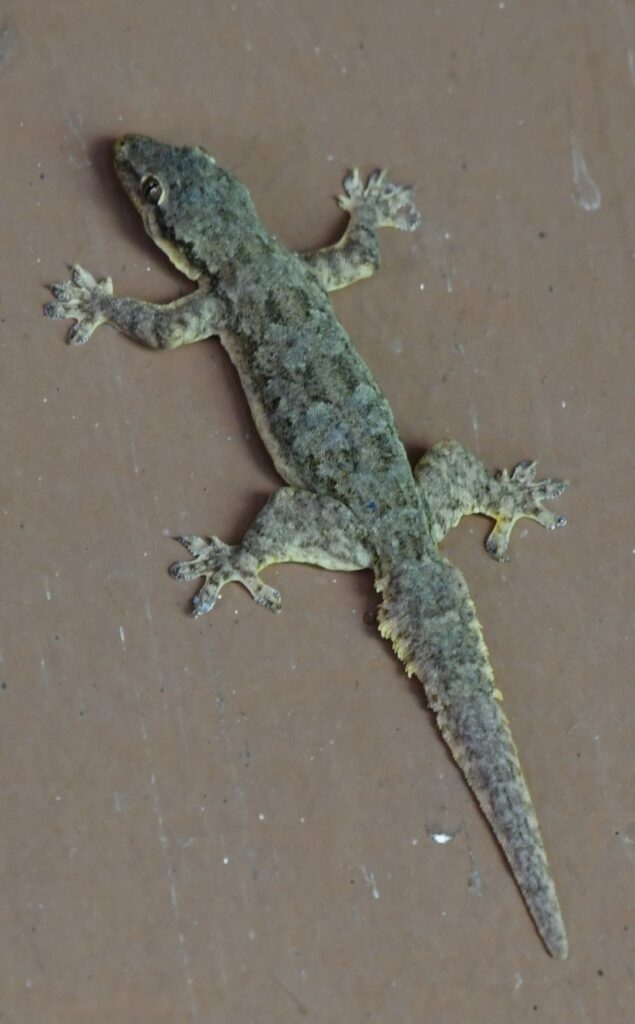
Nearly everywhere I traveled in Laos (see map below), forests had been severely degraded by logging and commercial developments. I often found myself birding roadsides, logging tracks and hunting trails, just to be near a sparse patch of secondary forest where birds might be found.
For safety reasons, I avoided my usual routine of randomly exploring the jungle. It wasn’t the poachers I feared. Rather, the prevalence of ancient American hardware – gifts from the heavens that keep on giving. An estimated eighty-million unexploded bombs remain in this part of Laos, mostly along the nearby Laos-Vietnam border. These rusty old devices, some weighing 100 kg, are known to occasionally detonate on contact (20,000 Laotians have been killed or maimed by ordnance since the war ended in 1975). Successfully avoiding those deadly antiques, instead, I often encountered locals with rifles, snares and other hunting gear, indicating their specific interests in zoology. Armed only with a camera and binocular, I carried a silent message of discontent. I’m reasonably certain most of them got it.

The simple truth is, Laos would benefit on multiple levels from a rigorous government education program aimed at protecting forests and wildlife, as has been done in other developing countries such as Costa Rica and Ecuador. Currently, efforts to halt deforestation in Laos have reportedly had mixed results. Some villagers have become recreational guides, e.g. for river-rafting and zip-lining. These are definitely steps in the right direction. If poachers could be convinced that learning some English and becoming a nature tour guide is more profitable for them than their current, illegal occupation, significant progress could be made in Laos (Fun Fact: In East Africa, ex poachers have become excellent game wardens). Meanwhile, wildlife forced to seek refuge in the most inaccessible mountain forests, e.g. Vangvieng and Na Hin, may begin to recolonize middle elevations and perhaps even lowland forests. Birds in particular, tend to be immediately responsive to shifting resources. If birds are no longer persecuted, they will habituate to the presence of people, an absolutely delightful transformation in our relationship with the natural world.
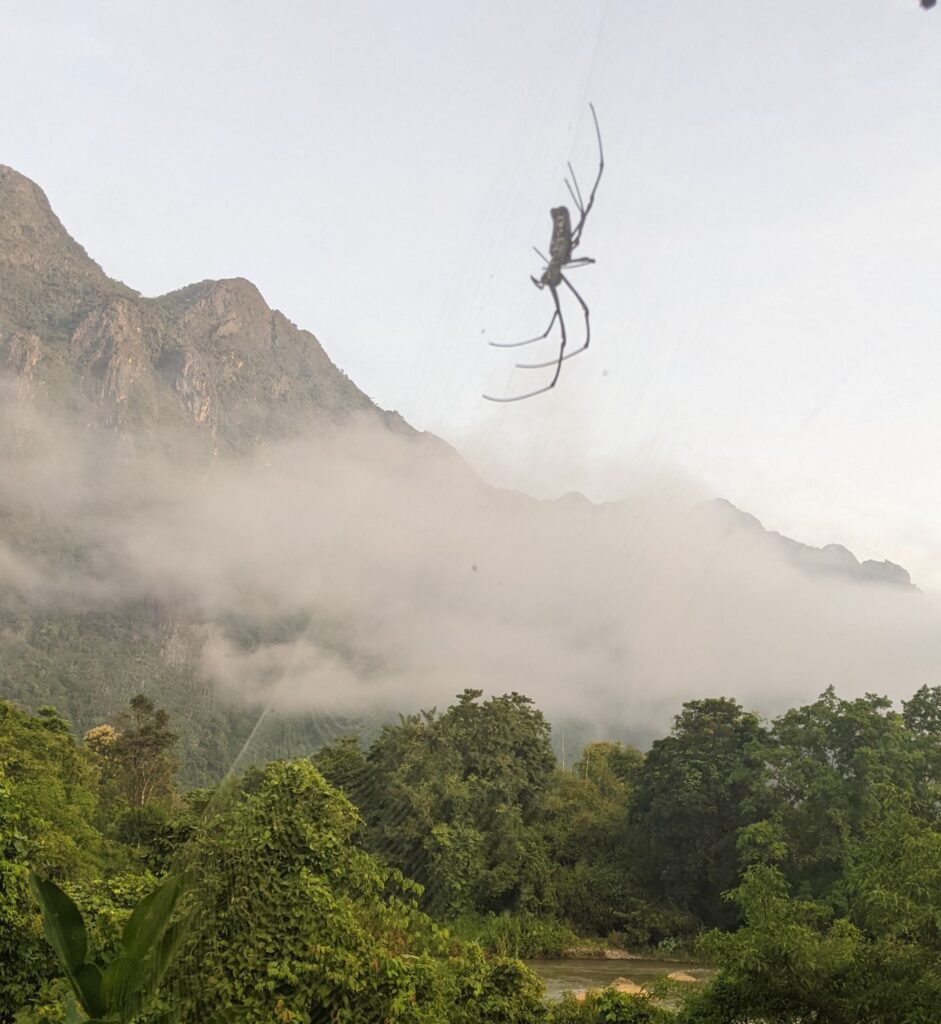
One day, while I was staying at the Vangvieng Ecolodge, the owner, Praphan Srisai, contacted a local trail guide, Ole, to accompany me into the nearby nature preserve, called ‘Ozone Park.’ His half-day fee for the service would be $US 20. I was delighted to learn that such an individual existed in this rural area, as I was determined to see some of the surrounding country – tantalizingly visible from my bungalow at the lodge.
The problem was access. Getting to the mountain forests would involve a crazy-wild motorbike ride, followed by a brisk 1.5 hour march through a maze of rice paddy fields and villages.
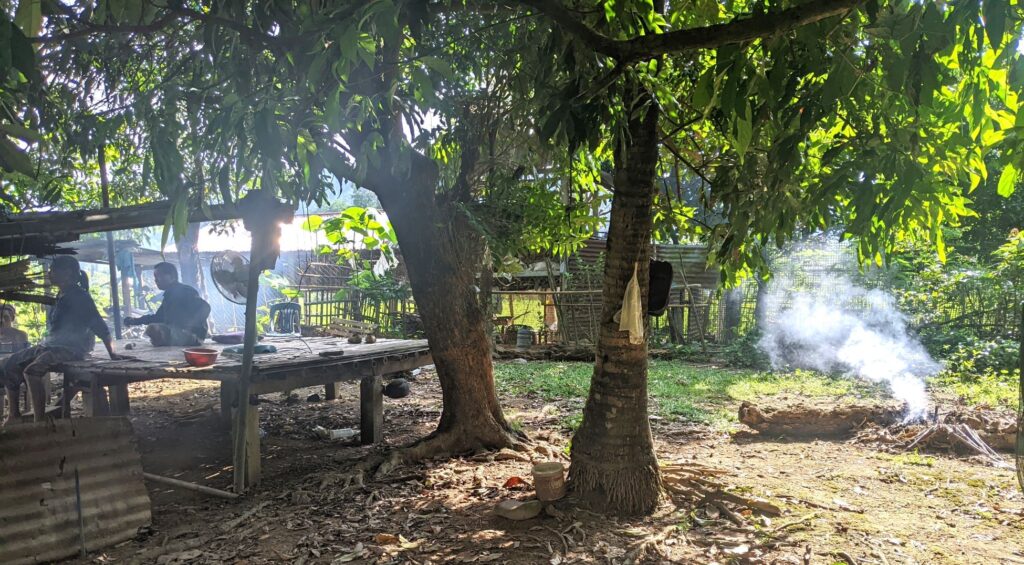
Ole picked me up at the lodge around 9:30 am on an old 100 cc Honda motorbike with rusty wheels and chain, a broken speedometer and gas gauge. We sped along, helmetless, mostly on village roads (rocky streambeds), for fifteen minutes or so, making two stops, the first for two liters of bottled drinking water, the second at his homestead next to a rice farm. I was introduced briefly to his father and relatives, chickens and dogs, the usual inhabitants in these rural villages. I couldn’t leave the place, however, before grabbing a quick snapshot of Ole standing in front of what had to be one of the most picturesque small rice farms in the world; a gap in the mountains marking the entrance to Ozone Park, appearing to be roughly a kilometer away, as the hornbill flies.
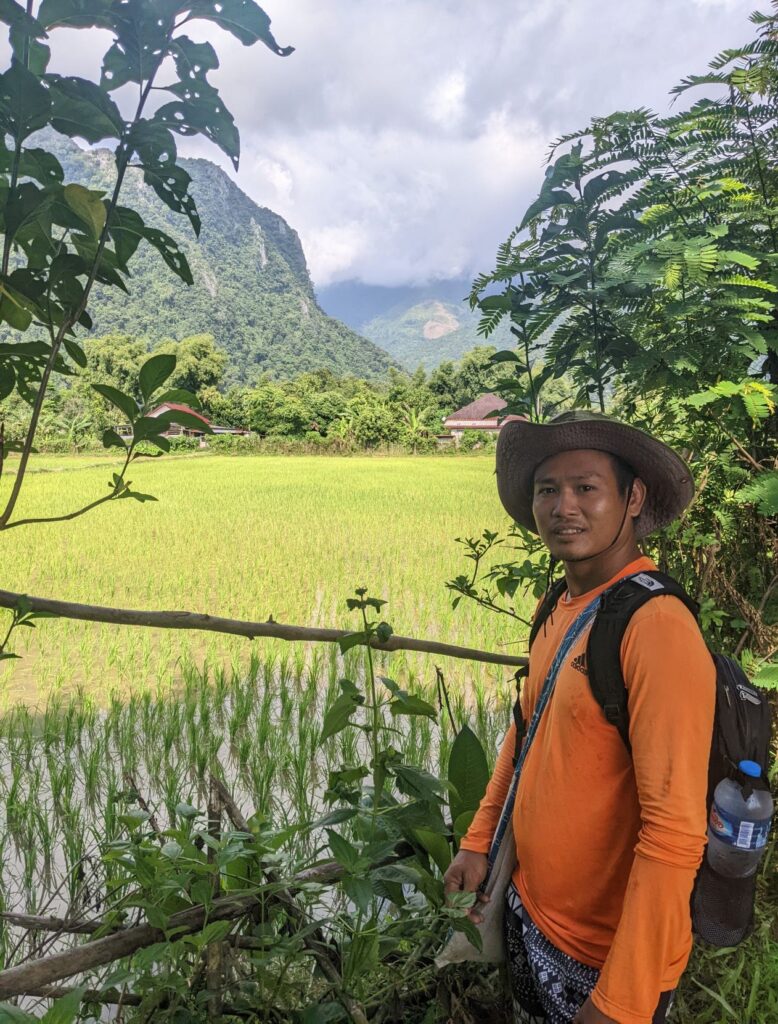
No hornbills or birds weighing more than about 20 g, were found along the way. The garrulous, ubiquitous Stripe-throated Bulbul (Pycnonotus finlaysoni) was about all that was active. Ole specialized in recreational hikes and related activities; birding was almost totally alien to him. Our trek into the mountains ended atop a saddle between two ridges, adjacent to the top most platform of a zip-line installation. The midday heat was building; I had consumed the entire contents of a small water bottle and 3/4 of the liter bottle of water Ole had wisely purchased. The view of a rugged canyon on the one side and a valley of rice farms on the other, was captivating, including the northern section of the Song River, the same one I had been living next to at the Vangvieng Ecolodge. At this elevation, about 400 m a.s.l., much of the mountainous area was still vegetated (largely second-growth) and promised to contain some interesting new species for my trip list. That wish may have come true had we arrived before 11 am, when bird activity generally tapers off.
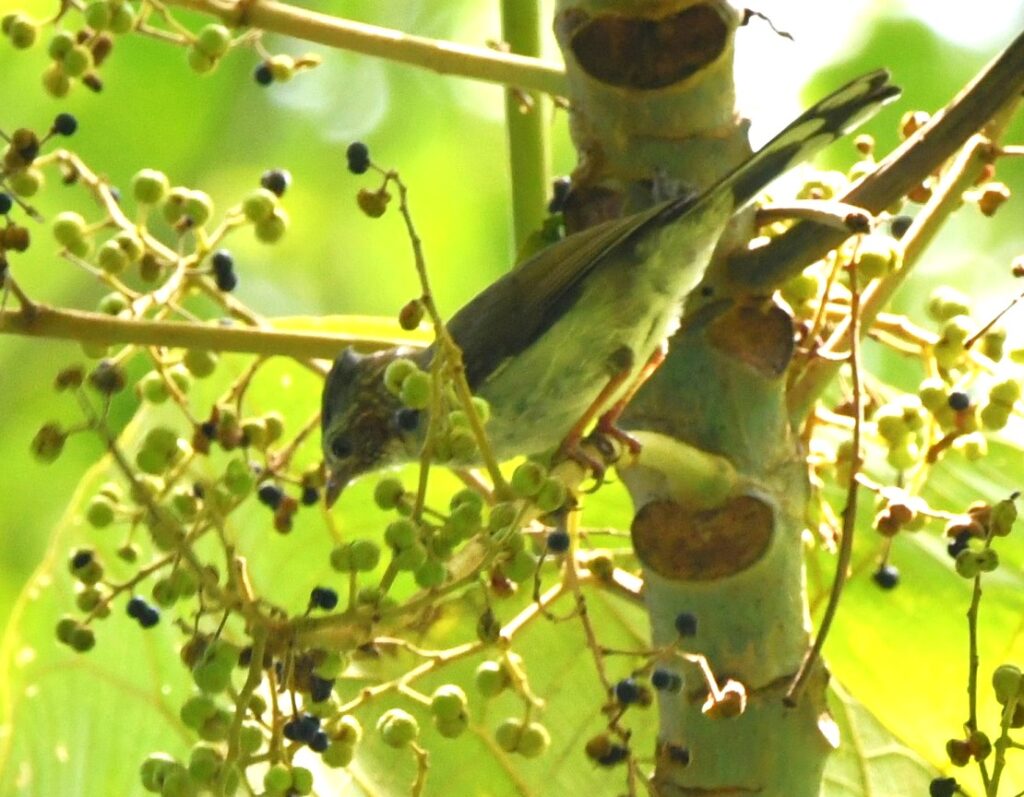
We did encounter one or possibly two different mixed species flocks of small birds, that moved quickly through the tree canopies – a bit too fast for me to assign most of them specific identities, e.g. Indochinese Yuhina (Yuhina torqueola), a species with which I was familiar with in central Vietnam. So, this area could well have had productive birding early in the morning. Again, the problem was access. Ole, suggested an overnight camping trip (a more common activity in the park that he had guided) but I was nearing the end of my scheduled stay in the Vangvieng region.
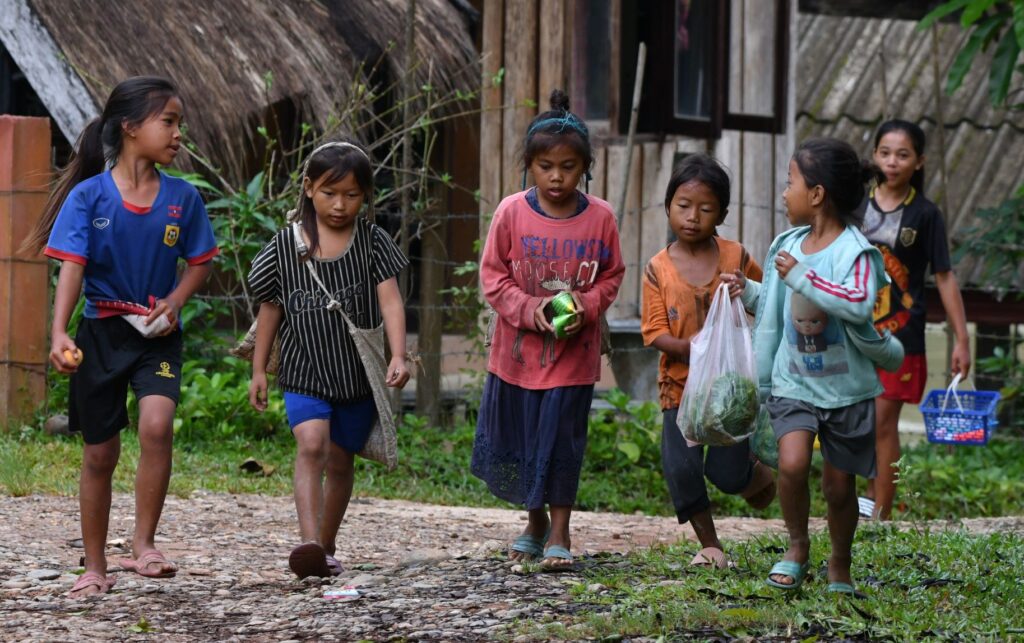
Arranging transport to potentially productive birding areas was problematic in Laos. Professional nature-guides, if present at all, were as difficult to find as large colorful birds. I was lucky having Ole in Vangvieng; not so fortunate in Vientiane. There, both taxi drivers for two separate trips, became thoroughly lost trying to find local birding spots published by other birders, then by me in the simplest English imaginable, together with Google street maps (largely useless in Laos). By the time we finally found the destination it was too late in the morning for most birds to be active. That, compounded with the fact that there weren’t many birds anyway, resulted in comparatively few additions to my Laos bird list.
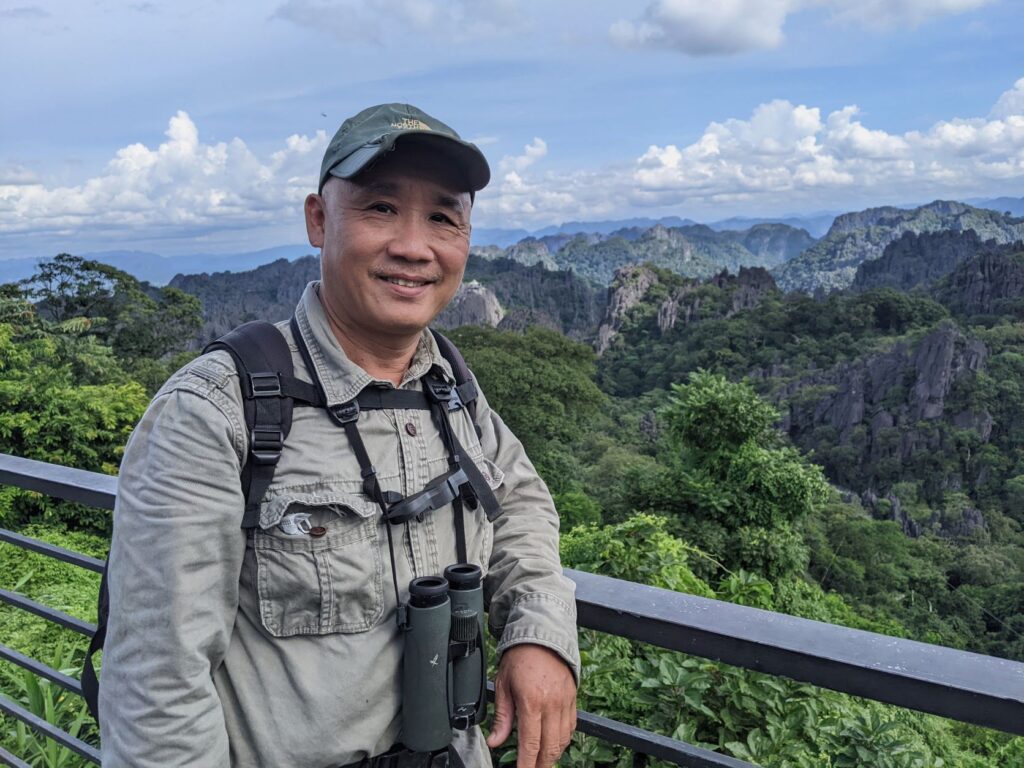
I had been warned about this issue before the trip by those with knowledge of Laos. Nevertheless, I reasoned that something might be spontaneously arranged for local birding trips, as I had done on numerous occasions in other parts of the world. But just incase that turned out to be untrue for Laos, I employed the services of my Vietnamese friend, Le Quy Minh, a professional birding guide, who arranged to meet me for a few days birding in Na Hin. In fact, it was Minh who had advised me that finding the special birds and mammals in Laos might be difficult without the assistance of an experienced guide. He was right on about that. Without Minh’s expert guidance in Na Hin, I could have easily missed the most sought after endemics noted above.
On The Road – Survey Areas, Methods and Materials
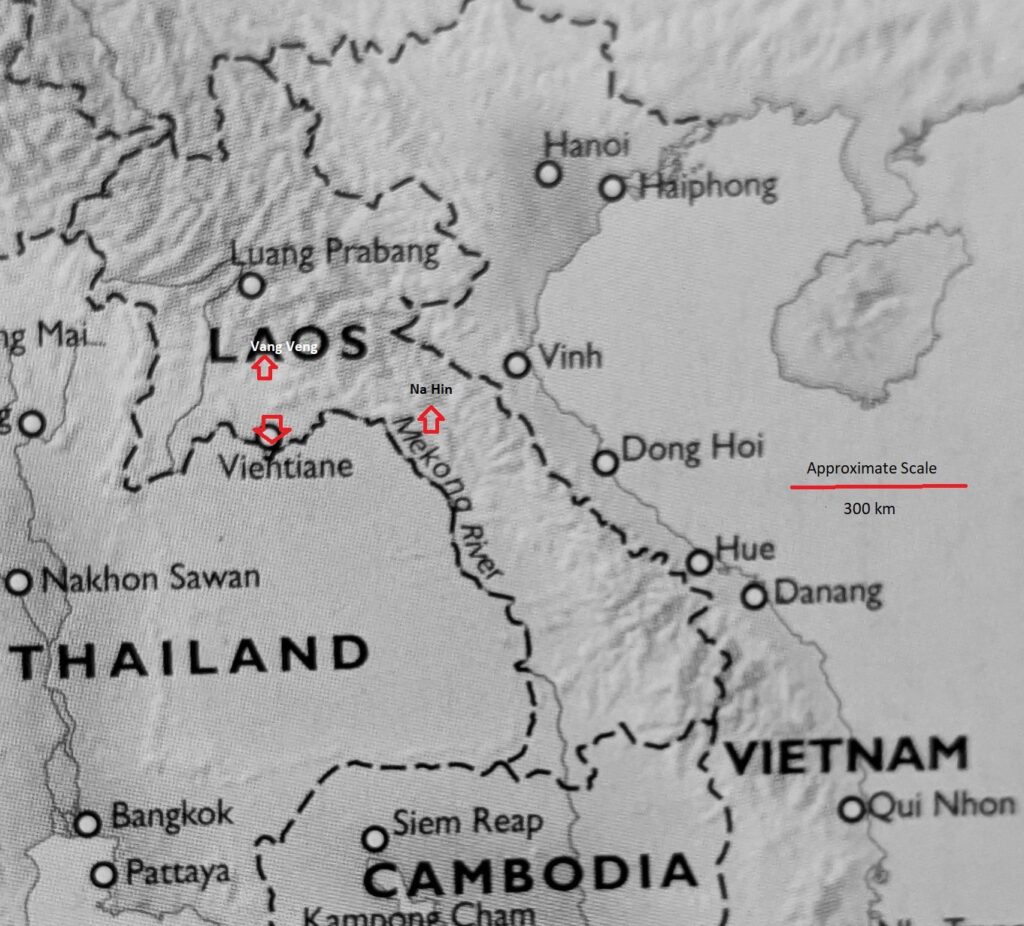
Vientiane
Vietnam Airlines flight #920 from Phnom Penh on an Airbus 321, made a hard-hitting, cowboy-style landing in Vientiane, Laos (Administrative Capital: Population 950,000) on the evening of July 26, 2022. I checked into the (1.5-star- my rating) Sunbeam Hotel ($30/night, no breakfast) nestled so discreetly in the busy night market district, that the taxi driver couldn’t find it without stopping three times and asking for directions. A friendly hotel clerk checked me in, gave me directions for getting around town, and led me up two flights of dimly lit stairs. The room was large and mostly empty; a tiled bathroom had a curtainless (wet) shower and leaky plumbing. I was glad I brought my own soap and bathroom supplies. The Sunbeam Hotel was about on par with an average European-style youth hostel. Since I would be there only for one night, and I was dog tired from a circuitous air-travel journey originating in Da Lat, Vietnam, with stops in Saigon and Phnom Penh (there were delays at nearly every juncture), the flop-house room was just fine.
The following morning at 6:30 am, I took my 10 x 42 binocular and camera (Nikon D850 and Nikon 200-500 mm lens) out to the Mekong riverside walkway, which at about 150 m from the river, was a combination of pavers and red dirt, littered with refuse from the evening carnival (a nightly affair in Vientiane). Flushing flocks of sparrows and starlings feeding amongst piles of trash, I walked in the upstream direction along the margin of a wide, seasonal wetland of tall grasses and scattered emergent shrubs alongside the Mekong, which forms the border with Thailand.
The southwest monsoon had arrived, so there would be little if any exposed mudflats to attract shorebirds – resident and/or early southbound migrants. Neither were there any paths through the marsh, except leading to a few makeshift homesteads with barking dogs. I walked slowly for an hour, covering a one-way distance of nearly 1 km, turned around and retraced my steps back to the night market area and Sunbeam Hotel. About fifteen species of bird were recognized, notably, numerous Red Turtle-Dove, Great Myna and one female Sunda Pied Fantail; most of the species were common and widespread in Southeast Asia.
Meanwhile, the young clerk who had checked me into the Sunbeam Hotel the evening before, had found transport to Vangvieng for me; upon returning from my bird walk, she informed me that a minivan would be picking me up at the hotel in twenty minutes. There was little time for breakfast or even a cup of coffee. The driver showed up ten minutes early and tossed my travel bag into the back of the van.
After an hour waiting in a hot parking lot, the minivan had a full load (myself plus about fifteen other passengers, wedged in their seats with about as much wiggle room as in an airport runway shuttlebus. It was a direct, two-hour drive to Vangvieng, with the air conditioner and radio blasting away all fears of catching COVID-19. Someone in the rear seat was coughing heavily. I leaned against the hermetically sealed window and tried to catch some shut-eye, hoping my four COVID-19 vaccinations in the States would save me. The one-way minivan fare, Vientiane to Vangvieng (130 km): $US 10. That was about the only comforting thought on the first leg of my overland journey in Laos.
By the way, everyone in Laos accepts either $US or the steadily declining Laos Kip (1 $US equaled 17,000 Kip, by the time I left on August 11, 2022). Generally, it was best to pay for everything in Kip, since prices for goods and services remained stable with the rising US Dollar. Unfortunately, the banks in Laos no longer buy back Kip. That latent discovery in the Vientiane airport, drove me like panicked water buffalo into the glass shelves of a tiny souvenir shop. Minutes later I emerged with a refrigerator magnet and a t-shirt featuring the Laotian alphabet; almost all of the Kip was still in my pocket. I guess I needed to learn the ABC’s of Laos banking. Evidently, I had made one too many trips to the ATM while in Laos (finding a serviceable ATM was always an adventure in Laos; the most reliable ones were usually in front of banks).
Aside from tuk-tuk (2-cycle motor-driven rickshaw), taxis (few and far between), expensive car-hire (one-way fare from Vientiane to Na Hin (215 km): $US 350) and minivans, transport between towns in Laos seemed haphazard and uncertain. Most of the cross-country busses in Laos originate in Vietnam, stop at the Vientiane bus terminal, then turn around and go back. I had no idea how to catch one until Quy Minh showed up one day and said that he would call a bus driver friend in Vietnam and ask him to stop in Na Hin to pick me up. Incredibly, it worked, despite there being nothing but a tree for a bus stop in Na Hin. The one-way bus fare for Na Hin to Vientiane (215 km): 150,000 Kip ($US 10). Hold onto your seats folks, the bargain adventure ain’t quite over. A tuk-tuk from the Vientiane bus terminal to the SureStay Hotel (6 km): $US 10; no extra charge for several stops the driver needed to ask directions.
Returning to Vientiane from Na Hin (August 8 -11), I continued doing bird surveys of the Mekong marsh, including visual surveys from the window of my 9th floor room (#903) in the SureStay-Best Western Hotel (4 Star: $US 60/night, breakfast included), around the corner from the Sunbeam Hotel, overlooking the Mekong and Thailand (photo). But by that time, the only functional camera I had was a Google Pixel 3X cell phone. A sudden downpour in the mountains near Na Hin on August 7, permanently disabled my Nikon D850. Fortunately, all digital images I had captured previously with that camera were retrieved from the two memory cards, which were moist when removed from their slots, yet still functional. Although the 200-500mm lens could later be salvaged, the D850 camera body, which had served me well since 2018, was a total loss.
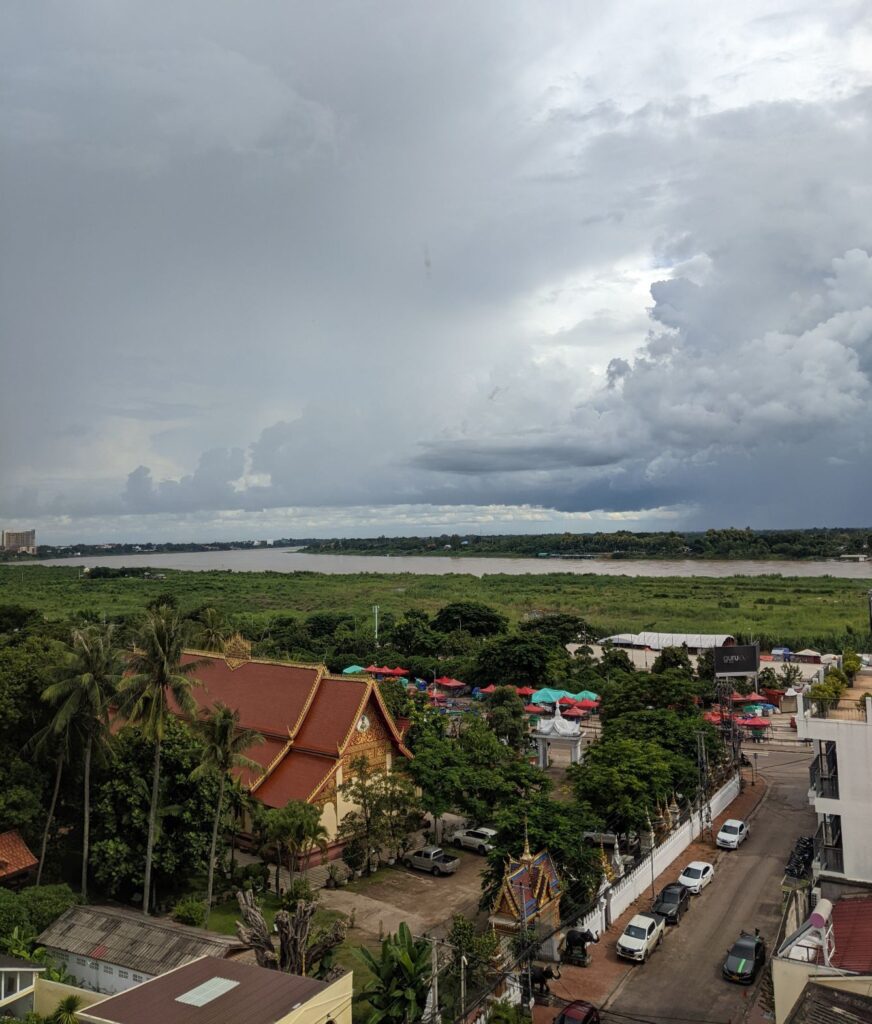
I walked about 2.5 km on the riverside walkway, mostly downstream, ending at the Landmark Riverside Hotel and returning the same route. The habitat was similar throughout, i.e. tall grass marsh with scattered shrubs and trees. There were also shallow, backwater channels near the walkway; those often had fishermen with nets. Almost no exposed mudflat occurred along my riverside survey route. One small, bare earth area had a 1m tall mist net suspended by two poles, set about 5 m apart. The netting was apparently placed to capture waterbirds or anything else flying low through the marsh. Nearby, a man dressed in military fatigues and carrying a rifle, was climbing the stairway out of the marsh.
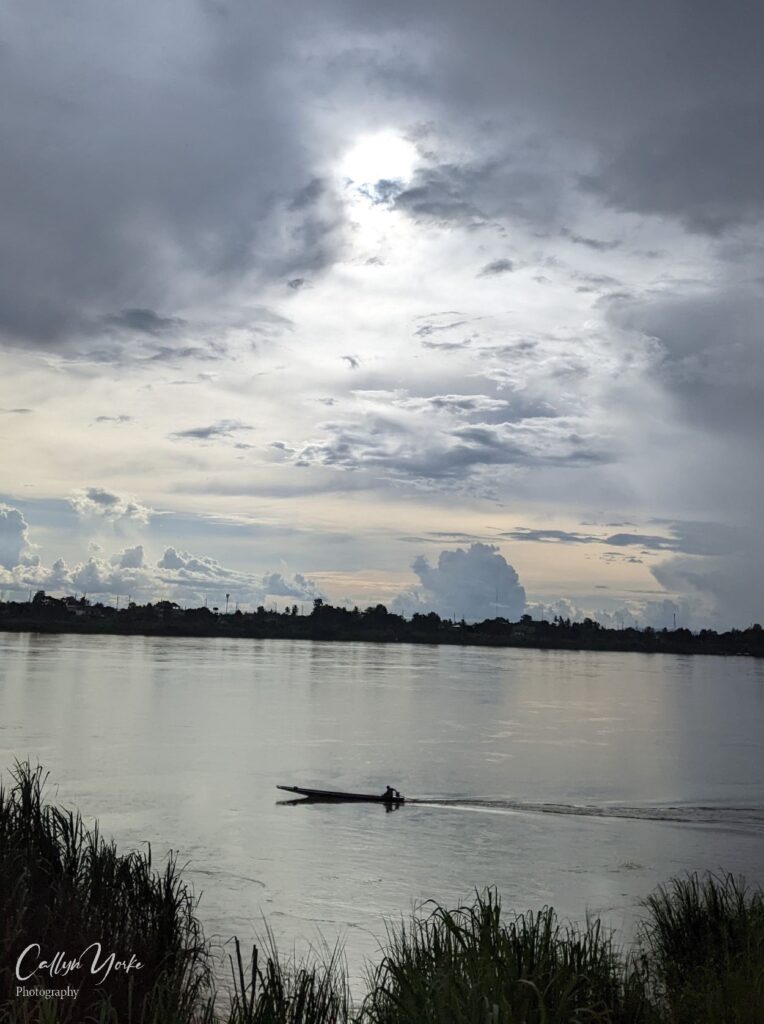
Birdlife in Vientiane consisted primarily of a few common species noted above and an occasional rarity. One afternoon, I spotted a Black-winged Kite in the marsh, seen from the hotel window, its field marks when perched and in flight distinctive enough for me to be confident of its identity. Other birds, seen flying downriver in the distance, were interesting and possibly new for my list, but could not be positively identified. It seems possible that during the dry season and with riverbanks of the Mekong exposed, additional bird species may be found in this area.
On two separate mornings, I hired a private taxi to explore wetlands, southward, 10-20 km km from the city center of Vientiane. Both of those trips, Nokkhan Marsh (9 August: 0820 – 0950 hrs.) and Kanxa Lake and Wetlands (10 August: 0824-0945 hrs.) produced new birds for my trip list, e.g. Golden-headed Cisticola, Zitting Cisticola, Plain Prinia, Brown Prinia, and Gray-breasted Prinia. However, considering the cost of private transport for those two locations ($20 and $50, respectively), together with a rather late morning arrival, I’m reluctant to recommend either of the two places as worthwhile for a visiting birder without their own transportation. If coming to Vientiane for birding, I would seriously consider renting a motorbike ($US 10/day) and using some sort of GPS device.
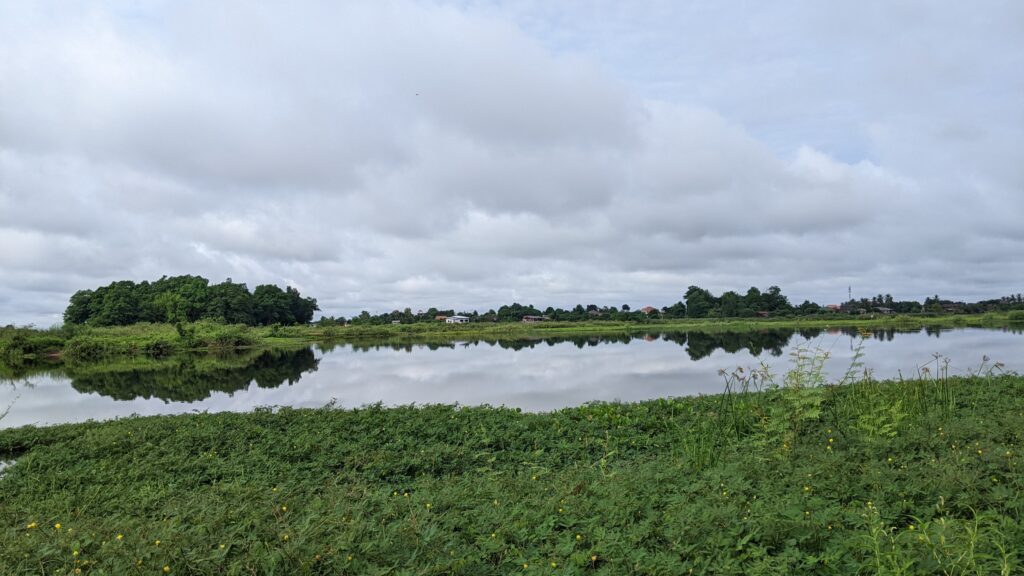
Annotated Bird List – Vientiane, Laos: 27 July; 8-10 August 2022 Callyn Yorke
KEY
Abundance: Numbers following each species entry are the maximum count for a single survey, when multiple surveys of an area were made (e.g. Mekong River & Marsh, 4 surveys). Age, sex and molt (when known): ad = adult; imm = immature; m = male; f = female; bsc plmg = basic (non-breeding plumage; alt plmg = alternate (breeding) plumage. Frequency: C = Common, i.e. found during all or more than half of the surveys; UC = found on fewer than half of the surveys; R = found only once. Note: some localities were surveyed only once, i.e. KLW & NM. Localities: Konxa Lake and Wetlands (KLW); Nokkhan Marsh (NM); Mekong River & Marsh (MRM); Vientiane streets, gardens & suburbs (VS) – see above Introduction for further location details; ubiquitous in the appropriate habitat (ubiq). Ecology and Behavior: aerial insect hawking (ah); taking fruit, berries or parts of flowers (fr); gleaning insects from foliage (ig); estimated height (m) above ground (agl); gregarious (greg).
Systematics and Nomenclature used herein is an amalgam from Handbook of Birds of the World, Clements Checklist of Birds of the World, and current (2022) online resources, i.e. Birds of the World, Cornell University, USA.
- Domestic Guineafowl Numida meleagris 2 greg. a pair walking on adjacent paddy field embankment, NM
- Lesser Whistling Duck Dendrocygna javanica 2 in flight over wetland, KLW
- African Comb Duck Sarkidiornis melanotus 2 a pair in flight 1/2 hr. prior to sunset, alighting in marsh, R, MRM
- Feral Rock Pigeon Columba livia 10 greg, C, VS, KLW
- Red Turtle-dove Streptopelia tranquebarica 25 greg, vocal, pairs on ground, in trees, roof tops and commuting back and forth across the Mekong at daybreak and dusk, C, VS, MRM
- Eastern Spotted Dove Spilopelia chinensis 35 greg., vocal, pairs on ground, in trees and commuting back and forth across the Mekong at daybreak and dusk, C, VS, MRM, KLW
- Zebra Dove Geopelia striata 6, vocal in trees, pairs on ground, C, VS, MRM
- Germain’s Swiftlet Aerodramus germani 2 gregarious, flying 2 – 20 m over marsh and edge of fown, C, MRM, VS, KLW
- Asian Palm Swift Cypsiurus balasiensis 2 loosely greg. flying 20-30 m agl over marsh and river, C, MRM, VS
- House Swift Apus nipalensis 2 flying 50-70 m over town and marsh, UC, VS, MRM
- Greater Coucal Centropus sinensis 1 vocal (unseen) KLW
- Asian Openbill Anastomus oscitans 25 greg., flock soaring 50-100 m above river, R, MRM
- Cinnamon Bittern Ixobrychus cinnamomeus 2 flying low over marsh, C, MRM
- Intermediate Egret Ardea intermedia 2 greg. a pair with intermittent, brief, low flights over adjacent paddy field and marsh, KLW
- Black-winged Kite Elanus caeruleus 1 flying low over marsh, alighting in small tree, R, MRM
- Marsh Harrier Circus sp. 1 f, perched in small tree surrounded by marsh, R, MRM
- Ashy Woodswallow Artamus fuscus 2 greg. a pair circling, 10-20 m agl over marsh and with scattered, isolated trees, R, MRM
- Sunda Pied Fantail Rhipidura javanica 1 f, ig in low shrubs and ground at edge of clearing, UC, MRM
- Double Zitting Cisticola Cisticola tinnabulans 1 repeated calls from tall grass in marsh, NM
- Golden-headed Cisticola Cisticola exilis 1-2 vocal in grass at edge of marsh, NM
- Brown Prinia Prinia polychroa 1 active on vine covered fence line bordering a garden, KLW
- Gray-breasted Prinia Prinia hodgsonii 1 popped up in tall, herbaceous growth and grass at edge of marsh, KLW
- Plain Prinia Prinia inornata 1 in low shrubs at edge of marsh and walkway, R, MRM
- Common Tailorbird Orthotomus sutorius 10 vocal, in shrubs and trees, C, ubiq.
- Asian Plain Martin Riparia chinensis 1 flying back and forth, 20 m agl over homesteads and wetlands, KLW
- Eurasian Barn Swallow Hirundo rustica 3 loosely greg. over river and marsh, C, MRM
- Red-whiskered Bulbul Pycnonotus jocosus 4 greg., vocal in trees at edge of riverside walkway, UC, MRM
- Streak-eared Bulbul Pycnonotus conradi 2 greg. a pair in a garden tree adjacent to the marsh, KLW
- Common Myna Acridotheres tristis 10 greg. loosely associated and less numerous while ground feeding in refuse and street litter with GRMY, C, MRM, at edge of paddy field, KLW
- Great Myna Acridotheres grandis 300 (conserv. est.) ad., imm. greg early morning flocks foraging in littered areas around night market; large flocks of 100 + birds at sunset, edge of town and marsh, pairs and small flocks flying north to roost sites over city at sunset south at sunrise, the dominant Acridotheres in Vientiane, C, VS, MRM
- Scarlet-backed Flowerpecker Dicaeum cruentatum 1 m briefly visiting tall, ornamental fruiting tree at edge of roadway, NM
- Olive-backed Sunbird Cinnyris jugularis 1 f in trees at edge of yard, UC, VS
- Streaked Weaver Ploceus manyar 1 flying low over marsh, KLW
- Scaly-breasted Munia Lonchura nisoria 8 ad, imm., greg. foraging in tall grass at edge of farm, KLW
- House Sparrow Passer domesticus 60 m,f, vocal, greg. loosely associated with EUTS but often separated by a few meters (primarily spatial resource partitioning between the two congenerics?), foraging in refuse on streets and ruderal patches, C, ubiq.
- Eurasian Tree Sparrow Passer montanus 120 m,f, vocal, greg. in msf and single sp. flocks throughout, C, ubiq.
________________________________________________________________
Vangvieng
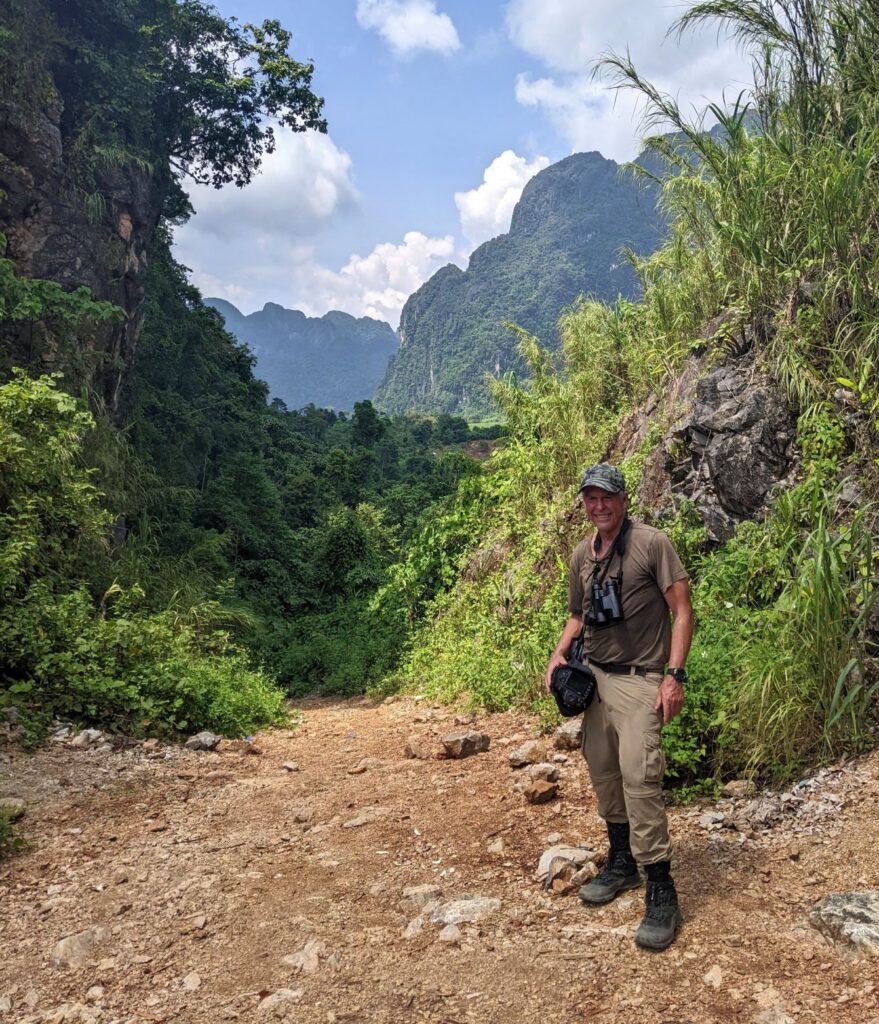
A two-hour minivan trip from Vientiane to Vangvieng went without incident on a new highway with almost no traffic. My plan was to call Mr. Praphan Srisai, the owner of the Vangvieng Ecolodge, and have him pick me up in Vangvieng. That seemed straight-forward except that I really had no idea where I was when dropped off. Like a lost dog, I followed another couple from the minivan across the street to a swank looking hotel.
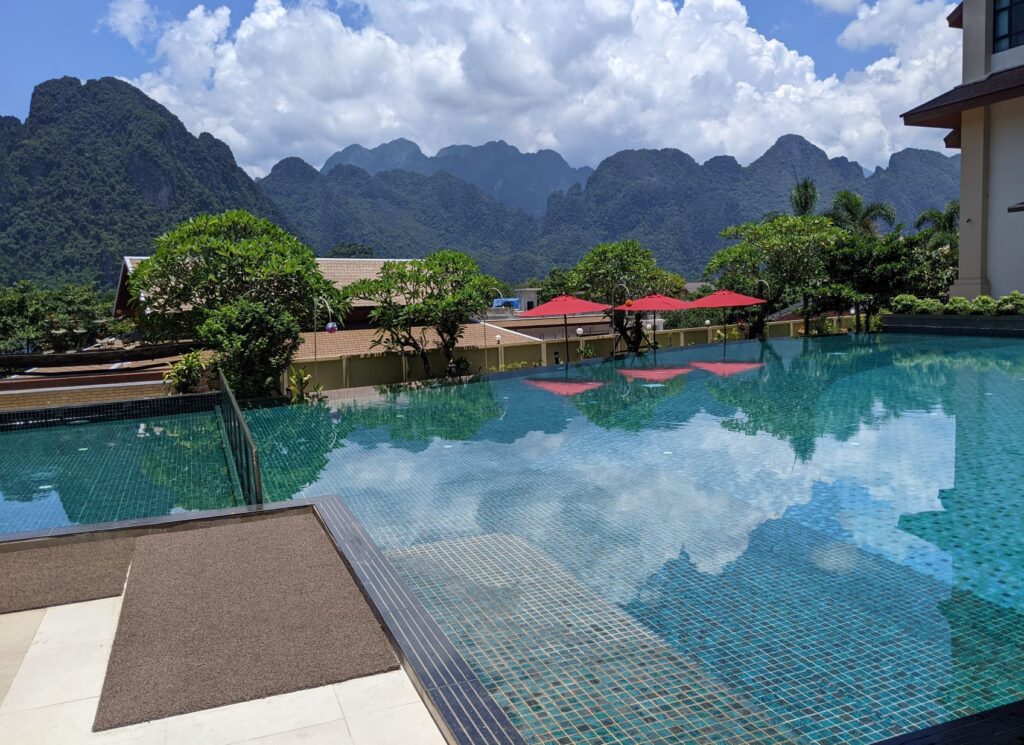
A hotel receptionist cheerfully agreed to call Praphan’s number (my cell phone wasn’t working in Laos); Praphan showed up about twenty-minutes later as I was eating lunch by the pool and soon we were heading back to his lodge about 15 km north of town.
We stopped at a local market for fresh fruit and vegetables, mainly foods I preferred, e.g. avocado, banana, mango, rambutan, kale and sweet potato. Praphan was happy to oblige me.
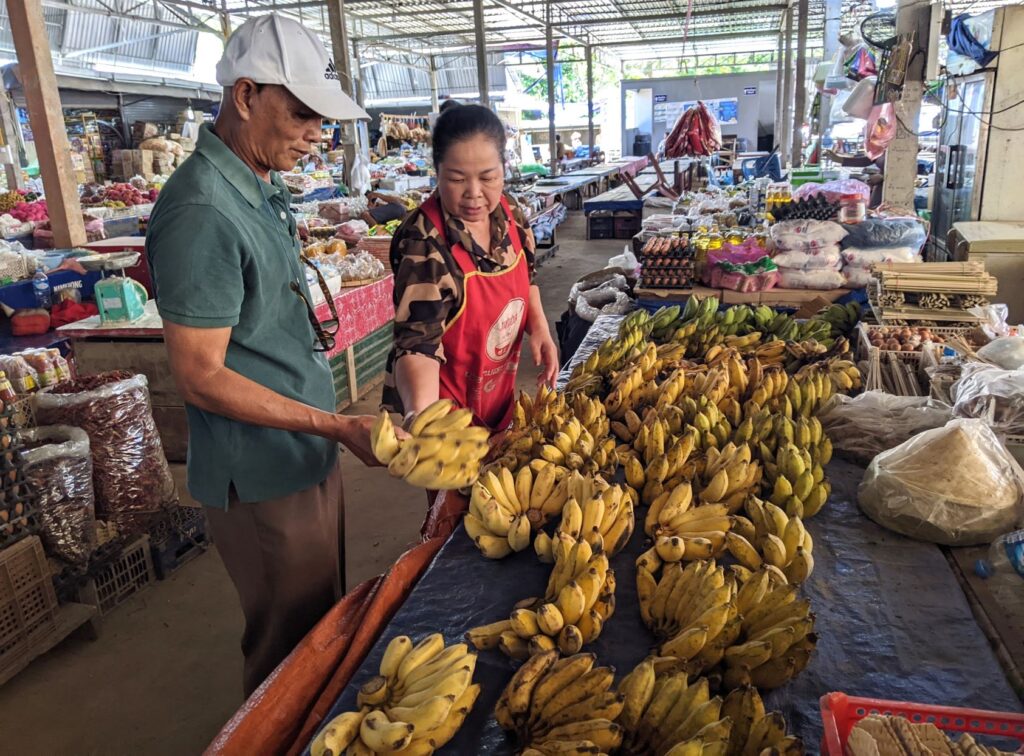
His wife, Ta, was the dining area supervisor and chef; she faithfully prepared the meals according to my food preferences. I was the only guest for the first three days, which made her kitchen duties fairly easy. Nevertheless, for some reason, she appeared on edge most of the time and occasionally was the recipient of harsh words from her husband. I understood from our casual conversations that the two of them, like many folks depending on tourism, had been through hard times during the pandemic. But I couldn’t help wondering if there was a bit more to the story than either of them wanted to share with their guests.
Otherwise, things went fairly smoothly at the lodge during my stay. There was no set mealtime schedule and that was fine with me. I could bird in the morning and when finished, sit down for breakfast overlooking the scenic Song River. Fieldwork usually lasted several hours each day, walking around the lodge grounds, riverside woodland, pasture, gardens and adjacent homesteads.
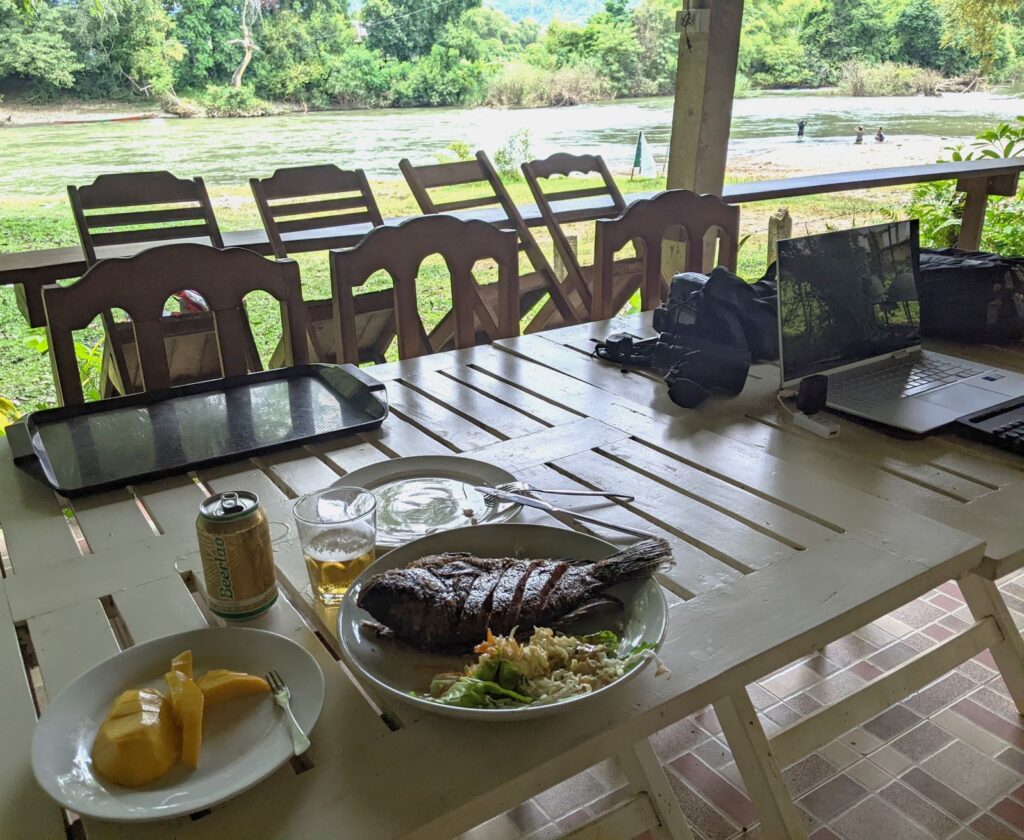
Birds were active and most easily found during the first two hours after sunrise, then again around 12-1 pm. Afternoon and evening thundershowers often prevented me from doing surveys later in the day. At those times, I relaxed in my bungalow overlooking the river and mountains. Sometimes, birds would appear in the shrubs and trees around the bungalow, but mostly they were shy and distant.
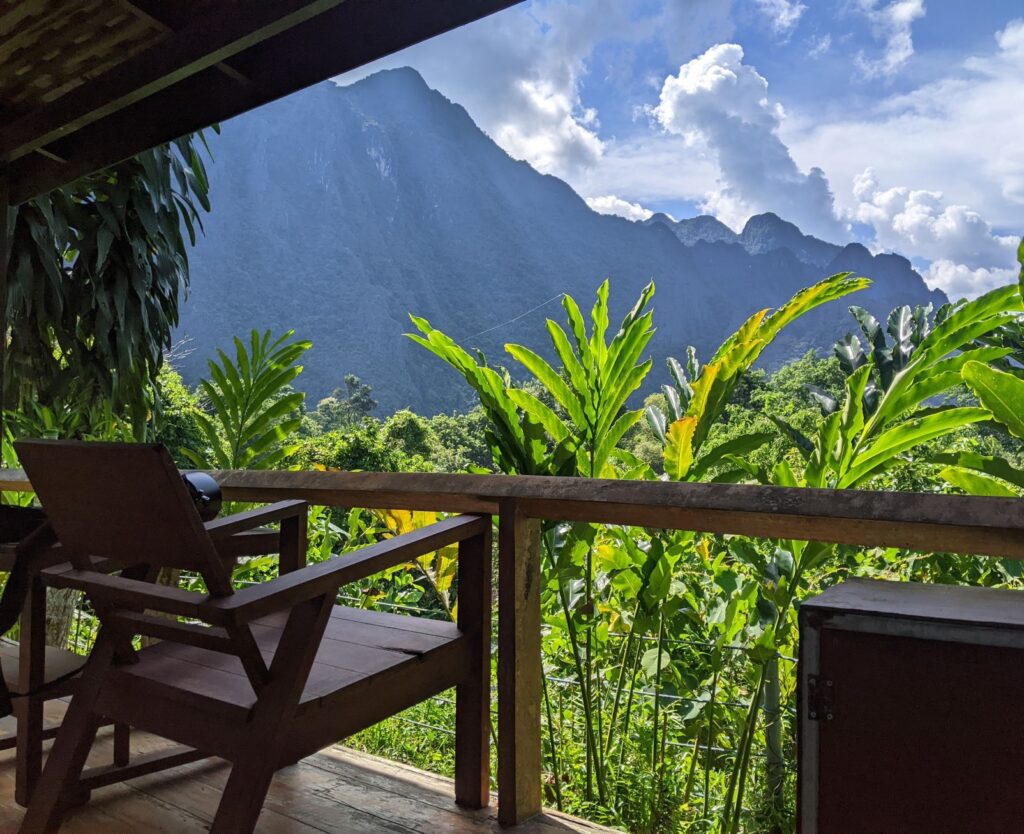
Vangvieng Ecolodge (elevation 290 m asl) consisted of a three-level hotel and several rustic bungalows, all overlooking the Song River. Praphan showed me the available rooms (essentially all were vacant – Laos was just emerging from a two year tourism hiatus during the COVID-19 pandemic). All of the rooms were clean, modern and well-appointed.

I chose one of the distant bungalows (#9) which had an inspiring view of the mountains; the river was mostly obscured by garden plantings and second-growth. Conveniently, one of the best birding areas I found in the Vangvieng region was a few steps from my front porch. But, as noted previously, that wasn’t saying much. My daily bird list was seldom more than fifteen species.
The Song River was the focal point for village life around the Vangvieng Ecolodge. Each morning and evening, dozens of villagers would be doing laundry, bathing, swimming and playing in the river. Fishermen worked the banks and shallows; a wooden skiff was used to ferry farm workers across the river twice a day. The lodge was located either accidentally or by design next to the favored swimming hole where lively beach parties occurred on weekends. It was clear that the Vangvieng Ecolodge philosophy, doubtless shaped by financial necessity, embraced the most liberal of environmental interpretations.
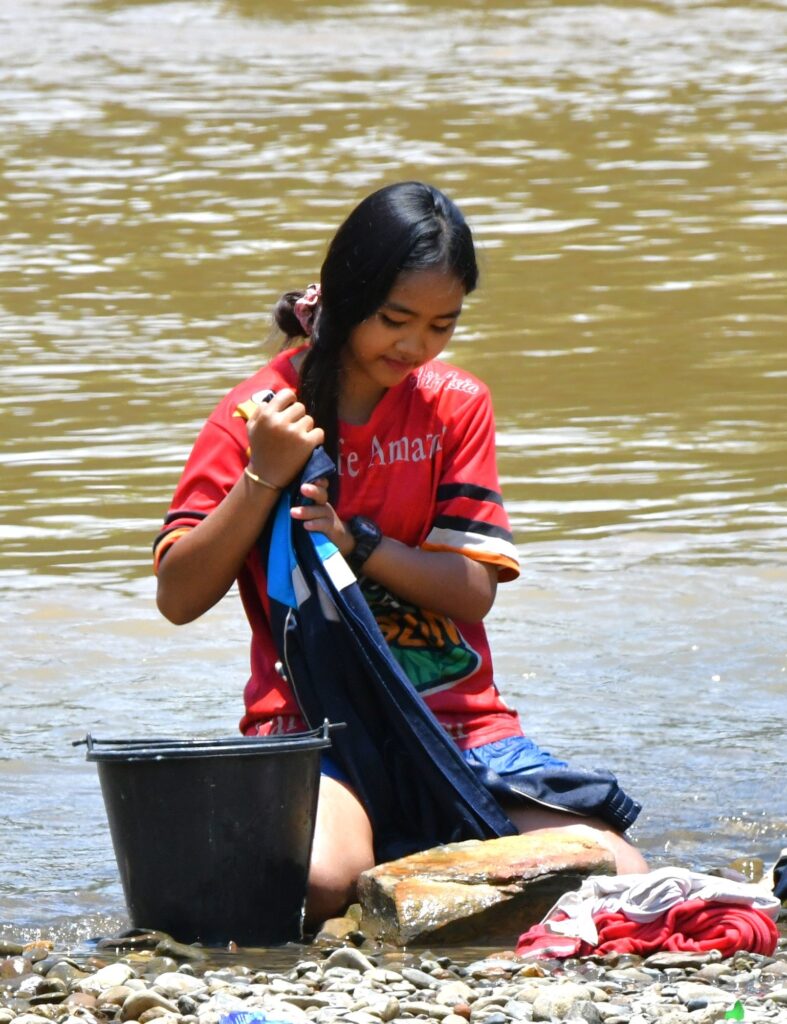
Obstacles to observing nature turned up everywhere. Local boys on their unmuffled motorbikes, rode the muddy riverside trails into the woods to make their shady deals, that I sometimes unintentionally interrupted while birding. In addition to avoiding drug deals and frisky dogs, I often wove in and out of cattle herds on local roads and footpaths, in an effort to find what few birds remained in the area. Evidently, hunters and trappers had done their work here. About the only meat left to consume was that from domestic animals and small fish taken from the river. Many villagers without their own land to raise livestock, depended on running their cattle along roadways and onto any unfenced property in search of forage. Apparently, “open range” grazing was ubiquitous in Laos, except in the larger cities. Not everyone was happy about it, however. Wandering livestock was often a traffic hazard on rural roads and sometimes an issue for Praphan and his workers, who had their own livestock, always kept within their fenced and gated property.
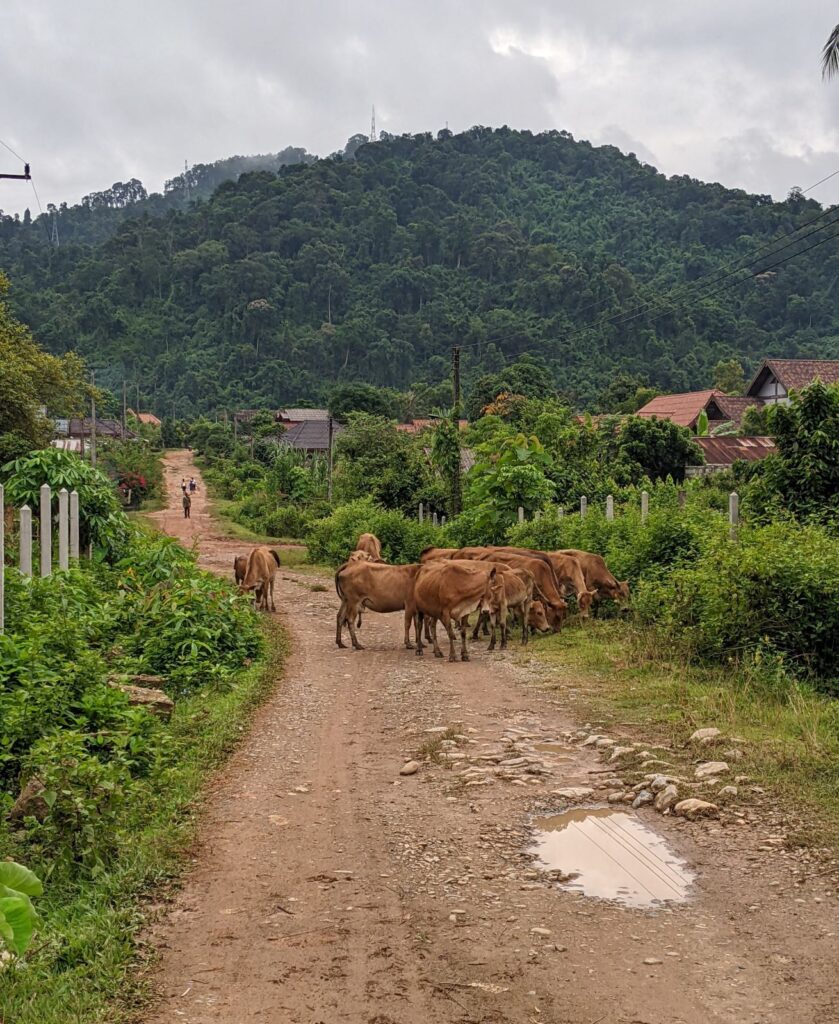
When using the main gate to the lodge, I had to be certain it was securely closed behind me, otherwise a dozen or so head of neighborhood cattle would trade places with Praphan’s herd. The open range cattle also came down to the river twice a day for water, leaving their fresh deposits everywhere; much of it going into the river during heavy rains. Occasionally, a maverick would become lost, and if not finding its own way home by the evening, a search and rescue posse would be out beating the bushes and calling for it. I have no idea how these unmarked animals were identified by their owners. Among the hundreds of free ranging bovids, everyone seemed to know which cows were theirs and which ones belonged to the neighbors.
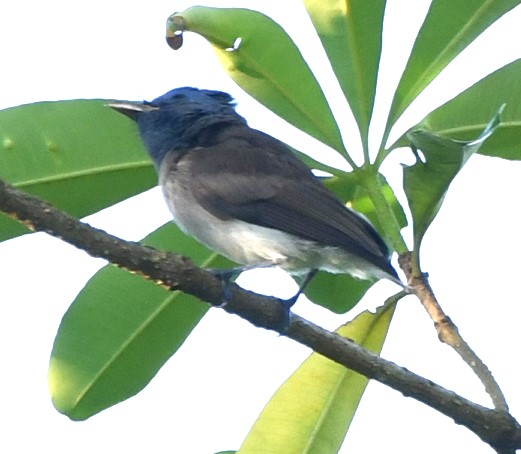
Having found pretty much all of the birds around the lodge that I believed could be found, I decided to cut my visit short by one day and head south to Ban Na Hin. I wasn’t sure exactly how to do that, since no cross-country transport arrangements had been made. Praphan had agreed to take me as far as Vangvieng, where I could catch another minivan back to Vientiane. From there, I figured that some form of transport would be going southward 220 km to Ban Na Hin. We settled my bill for the five nights plus meals at Vangvieng Ecolodge ($US 238) and headed for Vientiane in Praphan’s 2016 Mitsubishi SUV.
Striking up a casual conversation during the short ride to Vangvieng, I asked if Praphan might be interested in driving me directly to Vientiane. He agreed that it was possible if I could pay only for fuel, about $US 100 ($90 more than a minivan but $100 less than a private car hire to/from Vientiane). I was on a roll. My next question was, “Hey Praphan, how about driving to Na Hin?” I may have sounded more desperate than comical. To my surprise, Praphan replied, “Sure, that would be fun. It’s Monday and all the weekend guests are gone; the lodge is empty and quiet.” Besides, he said, “I have always wanted to see that part of Laos.” There was an awkward refrain in our conversation. I was elated and couldn’t believe my good luck. Praphan hadn’t even suggested a price for the extended drive, which would take us about seven hours on some of the worst highway roads imaginable (he later generously said that an additional $100 would be sufficient). Praphan made a couple of brief calls, one to his wife at the resort and the other to someone else. Then he asked me, rather hesitantly, “Would you mind if my girlfriend came along with us? We can pick her up in Vangvieng.”
His friend, wearing a short skirt and white blouse, stood waiting for us outside a modest home on a Vangvieng side street. I guessed she was in her early twenties; Leaning back slightly with one slender leg forward, she looked like she was ready for a beauty pageant. Coming up for air, my only question to him was, “Does she have a sister?” Praphan just smiled.
And so the three of us bounced along for several hours, southbound on Highway 13. We stopped for lunch near the junction of Route #8 eastbound, and arrived at the Sainamhai Resort in Ban Na Hin about an hour before sunset. We had covered about 350 km, dodging pot holes in the road; some large enough to conceal a small car. The second leg of an unforgettable journey through Laos had been completed. And, in retrospect, in terms of natural history, the most amazing part of my trip had just begun.
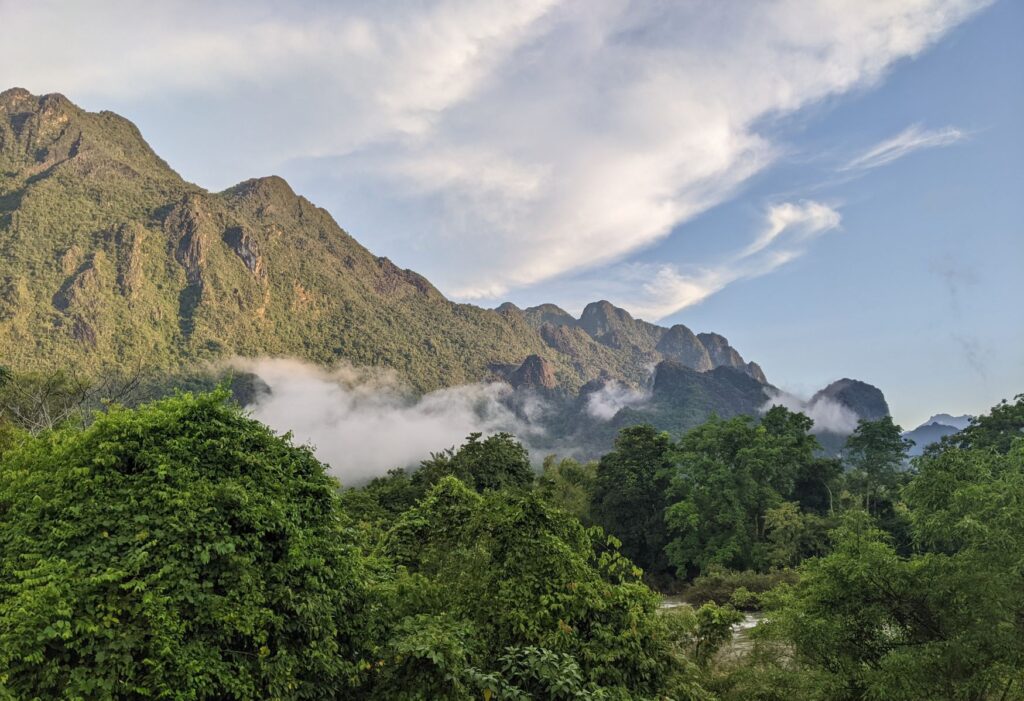
Annotated Bird List, Vangvieng, Laos: July 27- August 1, 2022 Callyn Yorke
KEY
Abundance: Numbers following each species entry are the maximum count for a single survey, when multiple surveys of an area were made (e.g. Vangvieng Ecolodge, 6 surveys). Age, sex and molt (when known): ad = adult; imm = immature; m = male; f = female; bsc plmg = basic (non-breeding plumage; alt plmg = alternate (breeding) plumage. Frequency: C = Common, i.e. found during all or more than half of the surveys; UC = found on fewer than half of the surveys; R = found only once. Note: some localities were surveyed only once, i.e. OP. Localities: Ozone Park and vicinity (OP); Vangvieng Ecolodge and vicinity (VE) – see Introduction for further location details; ubiquitous in the appropriate habitat (ubiq). Ecology and Behavior: aerial insect hawking (ah); taking fruit, berries or parts of flowers (fr); gleaning insects from foliage (ig); estimated height (m) above ground (agl); gregarious (greg).
Systematics and Nomenclature used herein is an amalgam from Handbook of Birds of the World, Clements Checklist of Birds of the World, and current (2022) online resources, i.e. Birds of the World, Cornell University, USA.
- Himalayan Swiftlet Aerodramus brevirostris 2 greg. flying 50-60 m agl in mountains, UC, VE
- Asian Palm Swift Cypsiurus balasiensis 3 flying 10-30 m agl over open fields, C, VE, OP
- Greater Coucal Centropus sinensis 1 vocal in second-growth at edge of rice paddy fields, C, VE, OP
- Banded Bay Cuckoo Cacomantis sonnerati 1 in tall broadleaved tree at edge of garden, UC, VE
- Plaintive Cuckoo Cacomantis merulinus 1 vocal in tall trees next to lodge entrance, UC, VE
- Common Iora Aegithina tiphia 2 vocal, greg. in fruiting trees, C, VE
- Great Iora Aegithina lafresnayei 1 ig, mid-level in secondary forest, OP
- Black-naped Monarch Hypothymis azurea 1 in mixed species flock, flowering/fruiting tree at edge of garden, R, VE (photo)
- Common Tailorbird Orthotomus sutorius 10 vocal, ig, ground-level to tree canopy, greg (pairs), C, ubiq.
- Eurasian Barn Swallow Hirundo rustica 2 flying 1 -20 m agl over open fields, OP
- Red-whiskered Bulbul Pycnonotus jocosus 6 ad, imm, vocal, greg. fg in tall garden trees, C, VE
- Northern Sooty-headed Bulbul Pycnonotus chrysorrhoides 8 vocal, greg., fg in garden trees, C, VE (photo)
- Stripe-throated Bulbul Pycnonotus finlaysoni 2 greg. vocal, pairs in fruiting trees and vines, shy and retiring, C, VE, OP
- Indochinese Yuhina Yuhina torqueola 1 in vocal, fast-moving msf with other small, insectivorous birds, mid-level to subcanopy, broad-leaved trees, OP (photo)
- Black-breasted Thrush Turdus dissimilis 1 m, perched quietly on horizontal branch in shady, vine tangled riverine scrub, R, VE
- Oriental Magpie Robin Copsyhus saularis 1 seen briefly in lower level of tree at edge of pasture, shy and retiring, R, VE
- Yellow-vented Flowerpecker Dicaeum chrysorrheum 2 ad fg, ig, associated with PLFL, C, VE
- Plain Flowerpecker Dicaeum minullum 2 ig, fg in canopy of garden trees, C, VE
- Olive-backed Sunbird Cinnyris jugularis 2 m,f ig in canopy of garden trees, C, VE
- Greater Crimson Sunbird Aethopygia seheriae 2 m,f ig, in canopy of garden trees, UC, VE
- White-rumped Munia Lonchura striata 25 m,f, imm, greg, foraging on stems of panicum grass, C VE
- Scaly-breasted Munia Lonchura nisoria 4 m,f gathering grass stems for nesting material; nesting low in garden tree, C, VE, OP
- Eurasian Tree Sparrow Passer montanus 6 m,f, greg. in gardens and second-growth where cattle grazed, C, VE
___________________________________________________________
Na Hin
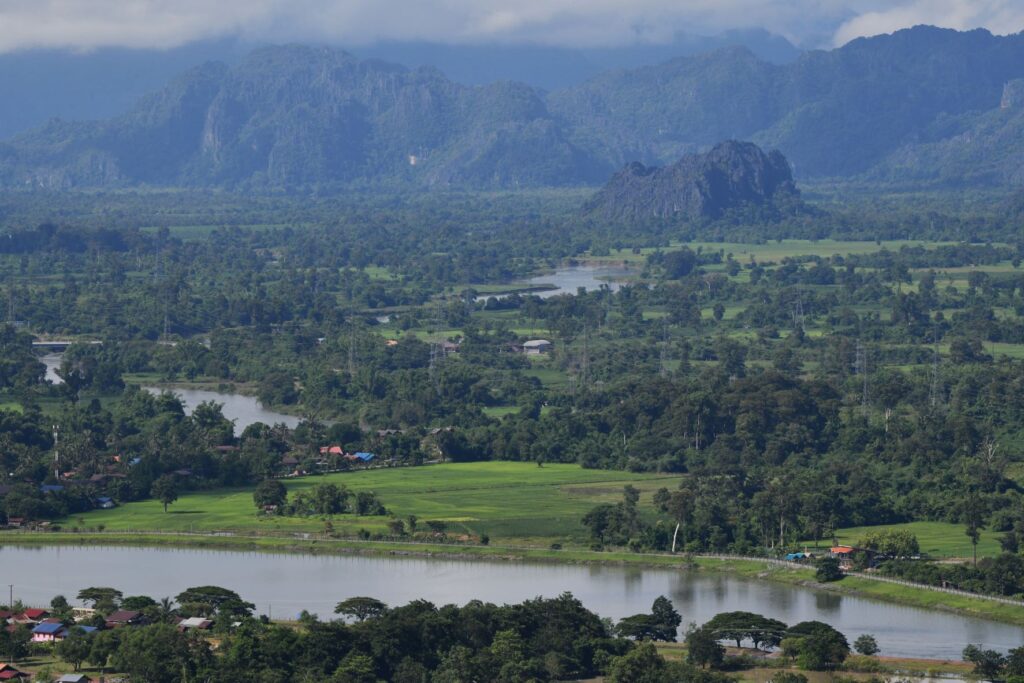
The Sainamhai Resort, on the outskirts of Ban Na Hin, was recommended by Le Quy Minh, who had led birding tours there prior to the COVID-19 pandemic. His contact for bookings was the owner, Vongsamay Malibayphit, who was very helpful and welcoming from the outset of our email messages and throughout my stay at the resort. As at the Vangvieng Ecolodge, I would be the only guest for the first three days and enjoy the singular royal treatment. Vongsamay and his wife were running the lodge themselves and, although quite busy with maintenance, farm work and other duties, made sure that all my needs were met.
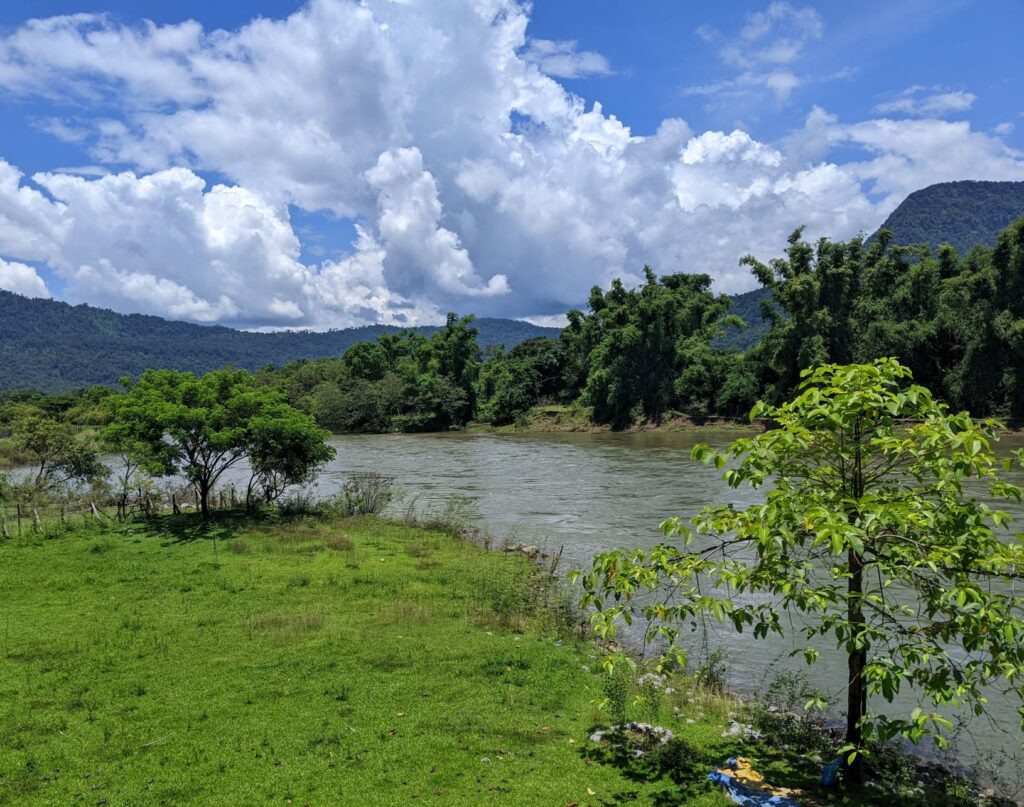
There were interesting comparisons to be made between the Vangvieng Ecolodge and the Sainamhai Resort. Both had a rural, riverfront setting with livestock, fruiting trees and a nearby village. Vongsamay’s place included a large, open dining area and several bungalows raised about 1.5 m from the ground. A few days after my arrival, heavy rains during the evening brought the river up more than 1 m, overflowing the banks and flooding the pasture in front of the dining area; a livestock fence was completely flattened. Afterwards, the neighbor’s water buffalo quickly moved in for a wet grass buffet. Perhaps due to comparatively light rains, no such event occurred at Vangvieng Ecolodge. Torrential rain was frequent in Na Hin and flooding was commonplace; raised buildings were a necessity. In contrast, Praphan’s property sat above a steep embankment in front of the river, that appeared to offer adequate protection from high water in the Song River.

Both properties supported a small, yet interesting assemblage of birds, though composed of different species. Such ecological differences between VangVieng and Na Hin were of interest to me, particularly with respect to the mountains adjacent to Na Hin. Those amazing, largely inaccessible limestone formations, were home to some truly unique birds and mammals, as I would soon discover.
Vongsamay and I went for a drive in his truck the morning following my arrival at the resort. After slowly cruising through the village and town, dodging many potholes and dozens of free-ranging cattle, we headed east into the mountains on the main highway between Vietnam and Laos, Route #8. We took a side track from the highway into a tall broadleaf evergreen forest. The bedrock east of Na Hin was partially eroded granite, which resulted in the forests being comparatively accessible. A few unidentified bird vocalizations were heard in the distance. Our brief tour of Route #8 included the scenic overlook of Na Hin and the Nam Hai Valley (see above photo).
Vongsamay was an informative tour guide, who had lived and worked in the Na Hin area for the past twenty years or so, employed by the local water department, prior to purchasing the 3.5-hectare lodge property, currently for sale ($US 300,000). Vongsamay described a massive water pipeline project tunneled through the mountains, that included a huge underground storage tank; the work spanned a period of about ten years and was completed in 2012. Hundreds of laborers were imported for the job and many of the once common species of bird and mammal ended up on the dinner table. He said that the forested mountains and wildlife have been slow to recover.
Then came the COVID-19 Pandemic, another severe blow to wildlife conservation in Laos. Locals continued to shoot birds and mammals in the forests; in fact the only maintained trails I found were those used primarily by hunters. Birds were generally scarce in the vicinity of Na Hin, though not as severely depleted as in the Vangvieng area. The only forests retaining much wildlife diversity, were those within the impenetrable karst formations a few kilometers west of Na Hin along Route #8.
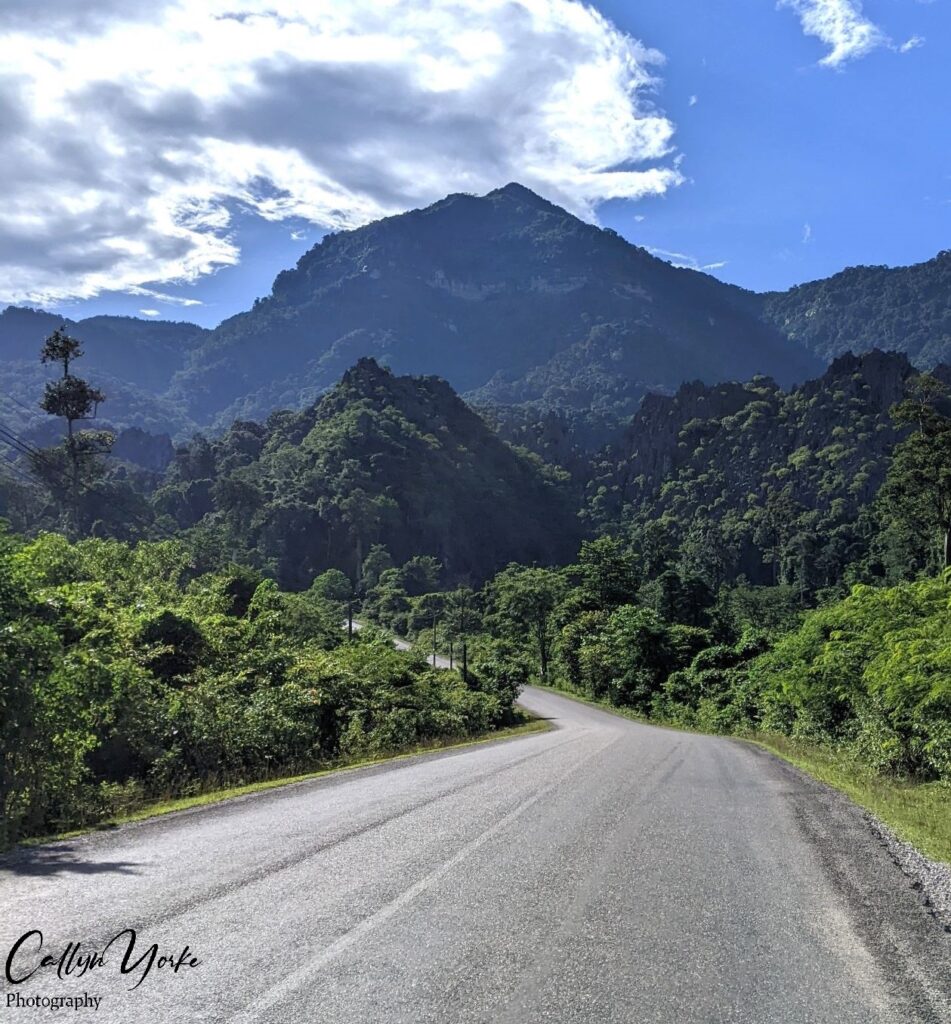
Nevertheless I was ready to explore the area in search of whatever birds and wildlife remained. For that task, I would need a motorbike. Vongsamay, always eager assist with my expeditionary requests, offered the use of his own 100 cc motorbike for $10/day. Considering the high cost of private transport in Laos, this wobbly little Vietnam-War-vintage bike was a bargain.
Over the next three days, I rode east and west of Na Hin on Route #8, in addition to exploring side roads throughout the scenic Nam Hai Valley. Not since my teenage years on a Bridgestone 50, had I enjoyed such freedom on a small motorbike, riding through a pastoral collage, framed by rugged, cloud enshrouded mountains; the wind in my face, carefree, navigating by distant landmarks and a fragmentary recollection of Vongsamay’s orientation tour. There was no point in stopping to ask directions; English was scarcely spoken in Na Hin. I was on my own to find my way around and back to lodge. All of this nonsense was great fun.
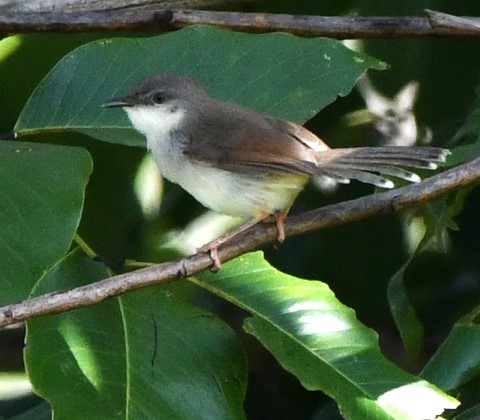
Best of all, my Laos bird list began to grow: additions included a family of Yellow-bellied Prinia on the lodge property, Pied Bushchat and Paddyfield Pipit in distant pastures and a pair of Blue-winged Leafbird on Route #8 about 2 km west of Na Hin. By the time Quy Minh arrived by bus from Vietnam around noon on August 4, I had about twenty-five bird species on my local list and a few more of uncertain identities. Minh and I would spend the next four days sorting out the mystery birds and adding quite a few more species to the list, including one of the most sought after birds in Southeast Asia.
The first afternoon of Minh’s arrival, we rode our rental motorbikes westward about 10 km out of Na Hin on Route #8, stopping a few times along the roadway to watch and listen for birds. Not much was moving. Minh, knowing this area and its avian inhabitants fairly well, soon had a flock of Bare-faced Bulbul on a distant high ridge; one bird was perched atop an upright fin of slate-gray limestone. The first glimpse of a life bird, which even at a distance of perhaps 200 m, appeared too large for a bulbul; it looked to be about crow-sized. But Minh insisted that the identity was correct, pointing out that it was a relatively large species of bulbul. I was optimistic, though a little frustrated. I worried that it might be as much as I would ever see of such an elusive bird. Minh seemed unconcerned. He calmly suggested we might have better views of the birds at the top. We continued riding to the road summit where a recreational zip-line facility had recently been developed.
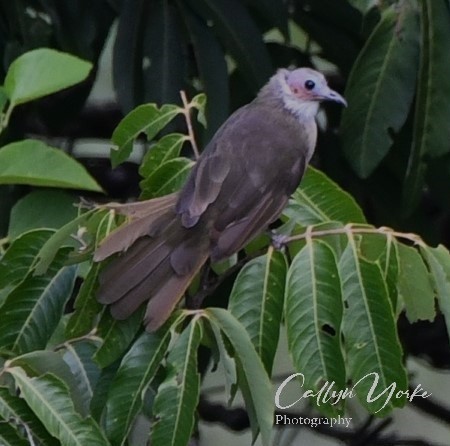
The facility, aptly named, ‘Rocky Viewpoint,’ included two observation decks just above eye-level with the forest canopy, and a lengthy set of staircases descending down into an intricate maze of limestone crevasses. Initially, we stayed on the elevated deck, waiting for a view of whatever this unique ecosystem had to offer. We scanned the ridges and forest canopy. In the foreground were shouts and screams from a series of helmeted zipliners, speedily on their way down to the next platform station, some 0.6 km away. Suddenly, Minh announced the discovery of an adult Laotian Langur, resting alone next to a Banzai-like tree growing between cracks in the limestone. An outstanding find! This handsome, endemic primate, related to Delacour’s Langur (a Vietnam endemic), was one of the special animals I had most wanted to see in Laos.
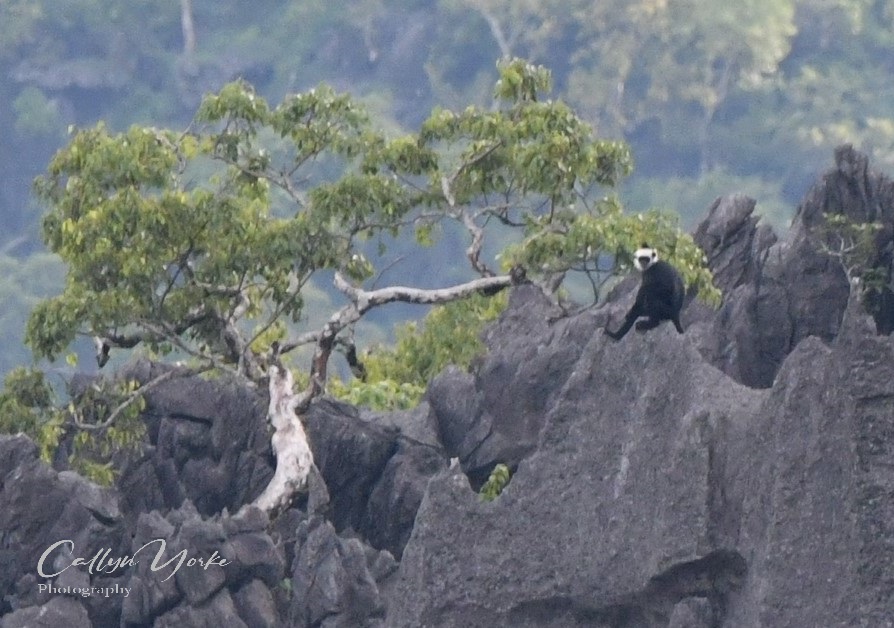
Then, as if summoned by the Laotian god of hidden treasures, a vocal flock of Bare-faced Bulbul alighted in a tree about 20m from where we stood. This time, the birds were well within camera range. Minh and I each made a series of rapid-fire shots using our Nikon 500 mm lenses, as the birds jumped between the outer limbs, going in and out of clear view. Fortunately, among the many images, were some keepers. We high-fived and kept watching the forest. The Bare-faced Bulbuls flew off and were replaced by a small flock of Black-crested Bulbul, a common species, widespread in Southeast Asia. Minh noted the vocalizations of Asian Barred Owlet, Great Barbet, Golden-throated Barbet, Red-vented Barbet, Puff-throated Bulbul and Scarlet Minivet, species I had not yet encountered in Laos. But the star of the show for both of us, and probably all birders coming to Laos, was this bizarre, endemic bulbul, which was first described by scientists in 2009. Interesting questions about its biology remain open for further investigations.
Among the most obvious questions was: Why would a bulbul species have a featherless head? This is the only species of bulbul, and actually one of the very few passerine species normally lacking head feathers in full adult plumage, c.f. Noisy Friarbird of eastern Australia. Most vultures also have featherless or nearly featherless heads; the adaptive significance of which has been attributed to their habit of impolitely plunging their heads deep into the bowels of juicy, decomposing carcasses. A feathered head in such delicious places might emerge looking rather untidy.
Unsurprisingly, that ‘just so’ textbook explanation has been challenged. A competing, (perhaps co-adaptive) explanation, is that a featherless head may be selectively advantageous for heat loss, i.e. improved thermoregulation in extremely hot environments, such as deserts and savannas (and paved parking lots?). I wondered about the second explanation with regard to the Bare-faced Bulbul. Could heat radiating from the dark limestone be a physiological challenge for birds living in that environment? Anecdotally, we observed no other bird species in the area perching directly atop exposed limestone ridges. Such a topic in physiological ecology would certainly be a worthy one for an ambitious young graduate student.
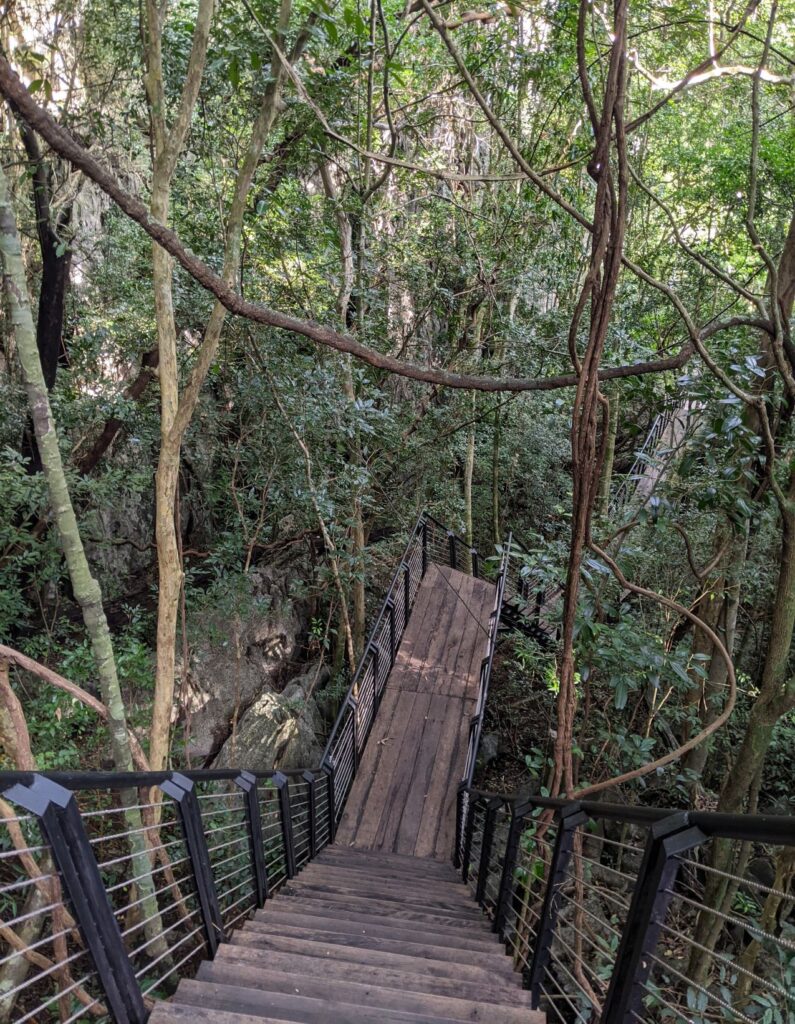
Finding and photographing the Bare-faced Bulbul and Laotian Langur was definitely a highlight of the trip. We wondered if there were more discoveries to be made within the forest ecosystem. Conveniently, a connected series of well-built staircases allowed Minh and I to delve deeper into the limestone formations and appreciate how utterly impassable these mountains were. Surely the engineering and construction of the staircases would have been quite challenging, since there was virtually nowhere to stand, except atop razor sharp blades of limestone; there was no open terrain for a trail and no connected ledges for a wall climbing route. Anyone stranded in this area, at best, could hope only for a daring helicopter rescue. Ironically, there were birds, e.g. Sooty Babbler and other animals, e.g. Laotian Rock Rat, living normal lives here and thereby rescued from certain doom, largely due to the difficulties humans have entering these forests.
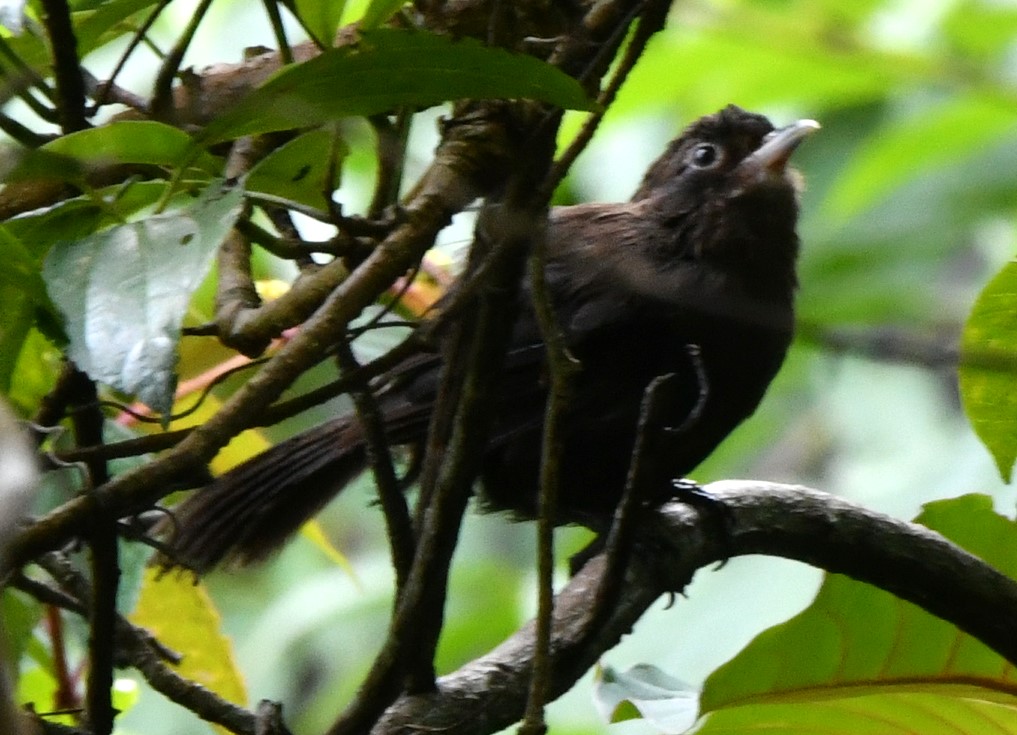
Spending a few more days exploring this area would certainly have been productive. These limestone mountain forests may contain the richest wildlife resources in Laos, if not all of Southeast Asia. There are likely numerous species awaiting discovery by science; limited accessibility due to extremely rugged terrain is at once, a species isolating mechanism and effective barrier to habitat loss, overhunting and extinction.
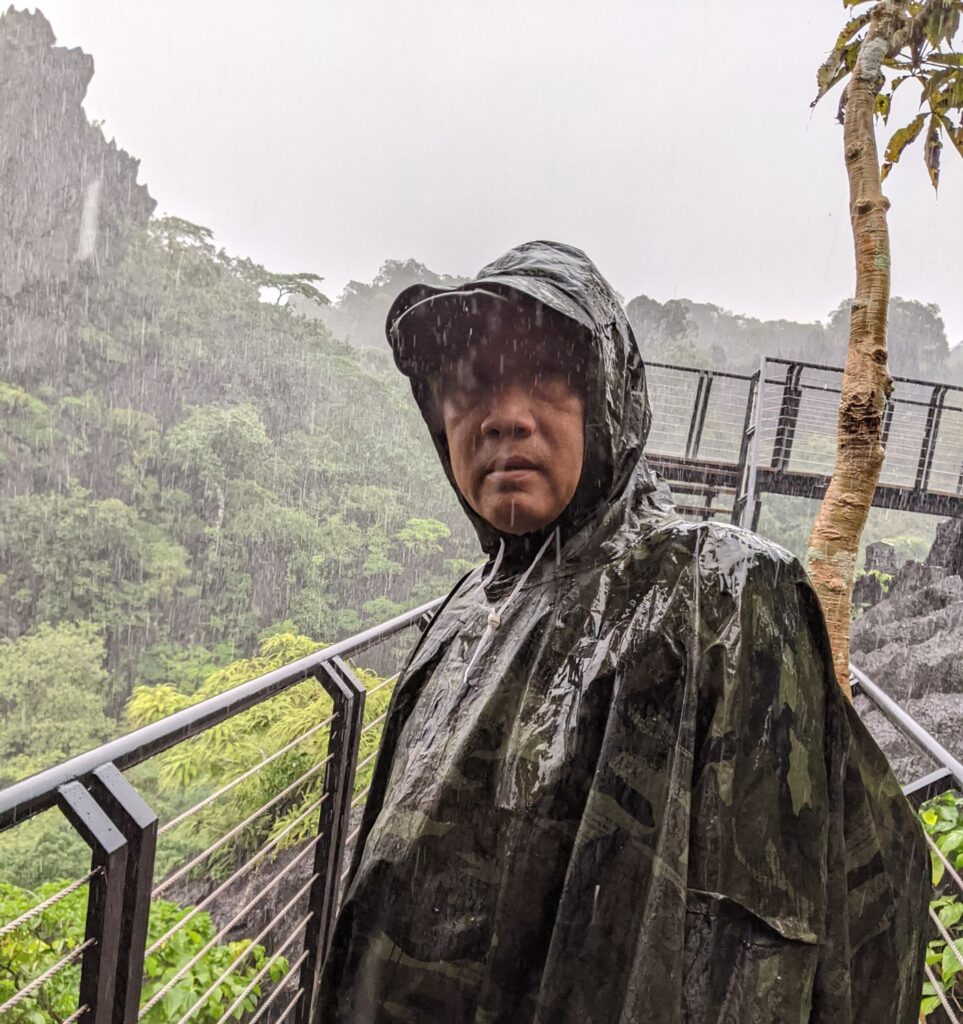
With the the rainy season now fully upon us, and my camera equipment completely useless, it was time to conclude the Na Hin segment of the journey. Minh would catch a bus back to Vietnam and I would return to Vientiane. Except for the Laotian Rock Rat, we had found and photographed the key birds (Bare-faced Bulbul, Sooty Babbler) and primate (Laotian Langur), along with several more species added to my wildlife list. Overall, the Na Hin safari had been successful, largely due to Quy Minh’s expertise and Vongsamay’s warm hospitality. On the morning of August 8, following a brief bird survey around the resort, I settled our account (Lodging $US 13 per night, breakfast included; $10/day for each motorbike; extra meals, $US 5-10 each). Vongsamay drove us to the Na Hin bus stop on Route #8, and we said our farewells.
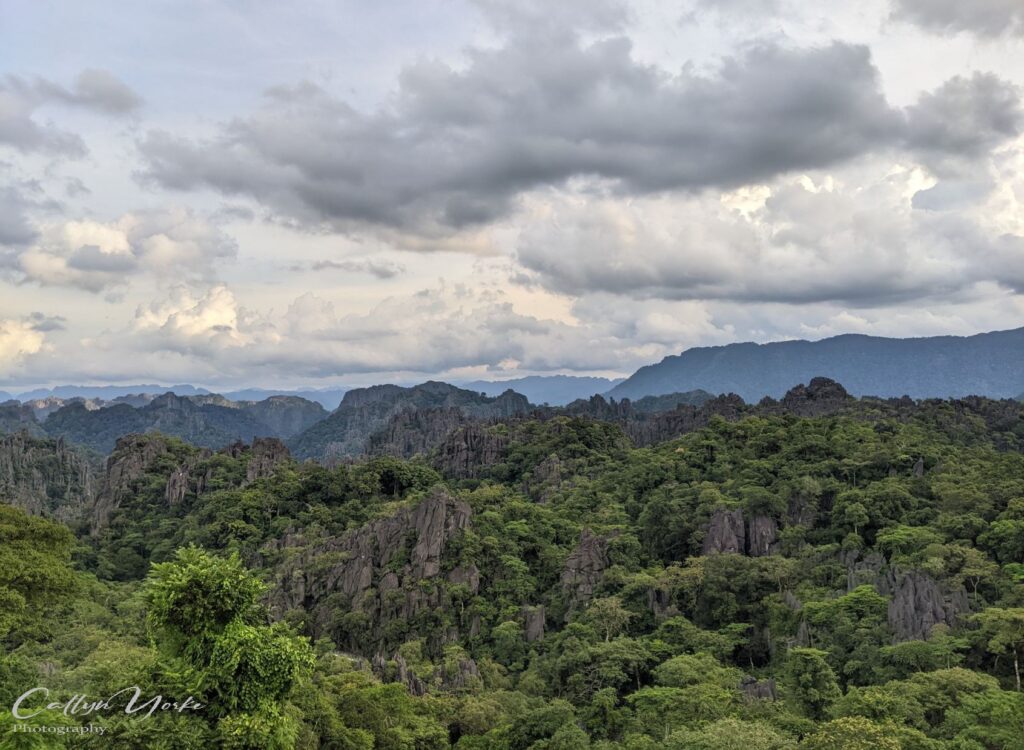
Annotated Bird List – Na Hin, Laos August 1-8, 2022 Callyn Yorke
KEY
Abundance: Numbers following each species entry are the maximum count for a single survey, when multiple surveys of an area were made (e.g. Sainamhai Resort, Na Hin, Nam Hai Valley, 7 surveys). Age, sex and molt (when known): ad = adult; imm = immature; m = male; f = female; bsc plmg = basic (non-breeding plumage; alt plmg = alternate (breeding) plumage. Observers: by Quy Minh only, QM; otherwise by both of us or myself; Frequency: C = Common, i.e. found during all or more than half of the surveys; UC = found on fewer than half of the surveys; R = found only once. Localities: Nam Hai Valley, including Sainhamhai Resort, Hai River, Na Hin water control channel and lake, Na Hin and adjacent villages, pasture, paddy field, riparian second-growth, small patches of secondary forest, gardens and weedy roadside (NHV: 7 surveys); Route #8 East, from central Na Hin, east to the Kham Keut District border, including side tracks into the forest (R8E: 4 surveys); Route# 8 West, predominately karst rainforest interior and edges, from west Na Hin truck checkpoint to summit at Rocky Viewpoint zipline facility (RVP: 4 surveys) – see Introduction for further location details; ubiquitous in the appropriate habitat (ubiq). Ecology and Behavior: aerial insect hawking (ah); taking fruit, berries or parts of flowers (fr); gleaning insects from foliage (ig); estimated height (m) above ground (agl); gregarious (greg).
Systematics and Nomenclature used herein is an amalgam from Handbook of Birds of the World, Clements Checklist of Birds of the World, and current (2022) online resources, i.e. Birds of the World, Cornell University, USA.
- Lesser Whistling Duck Dendrocygna javanica 2 pairs in flight over river and wetlands, UC, NHV.
- Eastern Spotted Dove Spilopelia chinensis 4 shy and readily flushed, pairs at edge of farms, C, NHV.
- Zebra Dove Geopelia striata 6 vocal, greg. in ploughed fields and gardens, C, NHV.
- Pacific Swift Apus pacificus 1 loosely associated with A. fusciphagus, 10-20 m agl, forest edge, UC, NHV, RVP
- Cook’s Swift Apus pacificus 2 a pair circling below cliffs over forest canopy, UC, RVP
- White-nest Swiftlet Aerodramus fusciphagus 25, loosely gregarious, 10-50 m agl, C, ubiq.
- Palm Swift Cypsiurus balasiensis 12 greg., flying 10 -40 m agl over wetlands and river, and forests, C, NHV
- Greater Coucal Centropus sinensis 4 vocal, individuals and pairs in overgrown pasture and open fields, vocal, C, ubiq. A rare example of a common and relatively abundant large bird in Laos; presumably this species has been saved by the belief that the flesh is toxic.
- Lesser Coucal Centropus bengalensis 1 vocal at edge of farm, R, NHV (QM).
- Green-billed Malkoa Phaenocophaeus tristis 2 a pair at edge of forest, R, RVP (QM)
- Banded Bay Cuckoo Cacomantis sonneratii 1 vocal (unseen) resort garden, R, NHV
- Plaintive Cuckoo Cacomantis merulinus 1 vocal after rains in resort fruit tree, UC, NHV
- Cinnamon Bittern Ixobrychus cinnamomeus 1 flying over paddy fields, R, NHV
- Asian Barred Owlet Glaucidium cuculoides 2 vocal in and adjacent to resort, UC, NHV
- Accipiter sp. 1 fairly robust, appearing from distance with the profile and behavior of PEFA; perched on high ledge above forest canopy for at least twenty-minutes, R, RVP
- Merops sp. 1 flying 10 m agl over field with scattered eucalyptus, R, NHV
- Common Kingfisher Alcedo atthis 1 on same low post early am in farm pond, C, NHV
- Smyrna Kingfisher Halcyon smyrnensis 1 vocal, open fields, UC, NHV
- Coppersmith Barbet Psilopogon haemacephalus 2 (vocal) in trees at edge of forest, R, R8E
- Red-vented Barbet Psilopogon lagrandieri 1 vocal (unseen) R, RVP (QM)
- Great Barbet Psilopogon virens 1 vocal (unseen), R, RVP (QM)
- Green-eared Barbet Psilopogon faiostrictus 1 vocal, alighted in fruiting canopy tree, R, RVP
- Lineated Barbet Psilopogon lineatus 1 vocal, flying over canopy, R, RVP
- Golden-throated Barbet Psilopogon franklinii 1 vocal (unseen) R, RVP (QM)
- Moustached Barbet Psilopogon incognitus 1 vocal (unseen), R, RVP (QM)
- White-browed Piculet Sasia ochracea 2 roadside scrub with small trees, R, NHV
- Common Flameback Dinopium javanense 1 vocal, flying over canopy beneath distant ridge, UC, RVP
- Eastern Black-naped Oriole Oriolus diffusus 1 vocal resort garden trees, R, NHV
- Scarlet Minivet Pericrocotus speciosus 1 vocal, forest edge canopy, UC, RVP
- Ashy Woodswallow Artamus fuscus 20 vocal, greg. circling 10-50 m agl; pairs and trios on utility lines and high metal towers, C, NHV (photo)
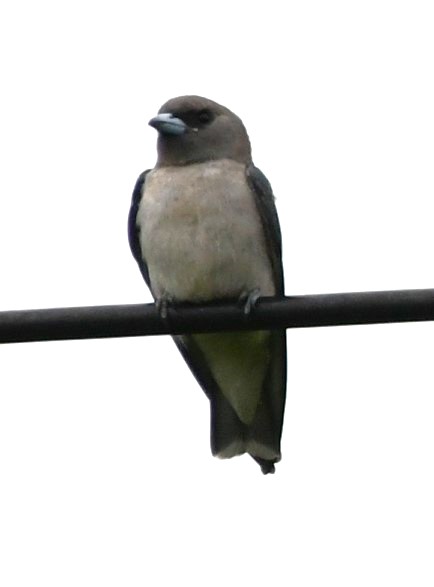
- Bar-winged Flycatcher-shrike Hemipus picatus 1 edge of old second-growth forest, R, RVP (QM)
- Common Iora Aegithina tiphia 1 vocal, mid-level of forest edge, UC, R8E
- Pied Fantail Rhipidura javanica 1 ig – with dragonfly, low shrubs in pasture, R, RVP (photo)
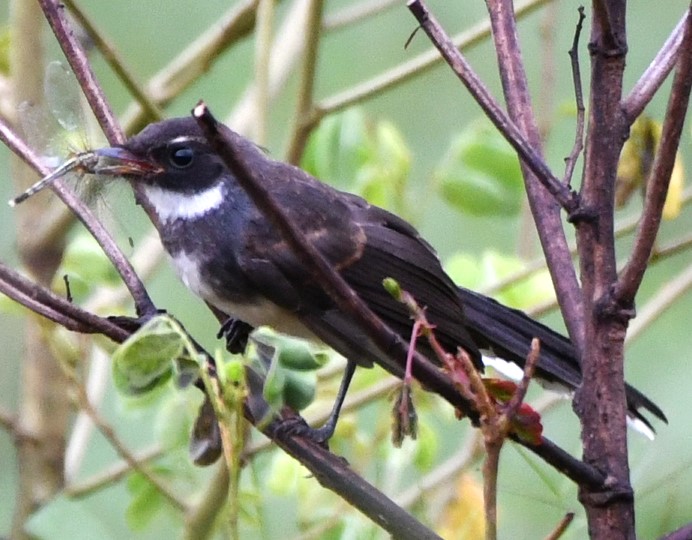
- Burmese Shrike Lanius colluriodes 1 in shrubs adjacent to pond and base of cliff, UC, NHV
- Rufescent Prinia Prinia rufescens 4 vocal, tall grass and second-growth bordering farms, C, NHV
- Yellow-bellied Prinia Prinia flaviventris 4 ad., imm, vocal, greg. resort garden shrubs and trees, C, NHV
- Common Tailorbird Orthotomus sutorius 10 vocal, active in roadside shrubs, forest edge, C, ubiq.
- Dark-necked Tailorbird Orthotomus atrogularis 3 vocal, active in forest understory and small trees, C, RVP
- Asian House Martin Delichon dasypus 2, flying 20-40m agl over open areas, UC, NHV
- Eurasian Barn Swallow Hirundo rustica 20 greg. flying 20-50m over wetlands, pastures and river, C, NHV
- Gray-eyed Bulbul Iole propinqua 1 vocal in forest below observation deck, R, RVP (QM)
- Puff-throated Bulbul Alophoixus pallidus 1 vocal in forest below observation deck, R, RVP (QM)
- Bare-faced Bulbul Pycnonotus hualon 8-12 (ad, imm?) vocal, highly gregarious; probably two or three separate flocks (family groups?) were seen from the observation deck during a period of about one hour, visiting fruiting forest trees for several minutes, then flying off in the distance, low over the forest, 0.5 km and further, sometimes alighting momentarily atop high limestone ridges. A flock coming close to the observation deck could have been responding to Minh’s loud playback recordings of their calls and song, but not strongly so. It is likely other birding groups have used the playback recordings to attract these birds, which may now be habituated and reluctant to respond. The best way to find these birds is to simply wait, listen and watch for them, as they appear to be closely associated with the most rugged karst rainforest, flying swiftly and frequently over large areas, C, RVP
- Black-crested Bulbul Pycnonotus flaviventris 4 vocal, greg. in forest below observation deck, C, RVP
- Stripe-throated Bulbul Pycnonotus finlaysoni 5 vocal, greg., second-growth and forest edge, C, ubiq.
- Yellow-vented Bulbul Pycnonotus goaivier 2 in resort garden fruiting trees, UC, NH
- Streak-eared Bulbul Pycnonotus conradi 5 vocal, greg. in resort garden trees, C, NHV (photo)
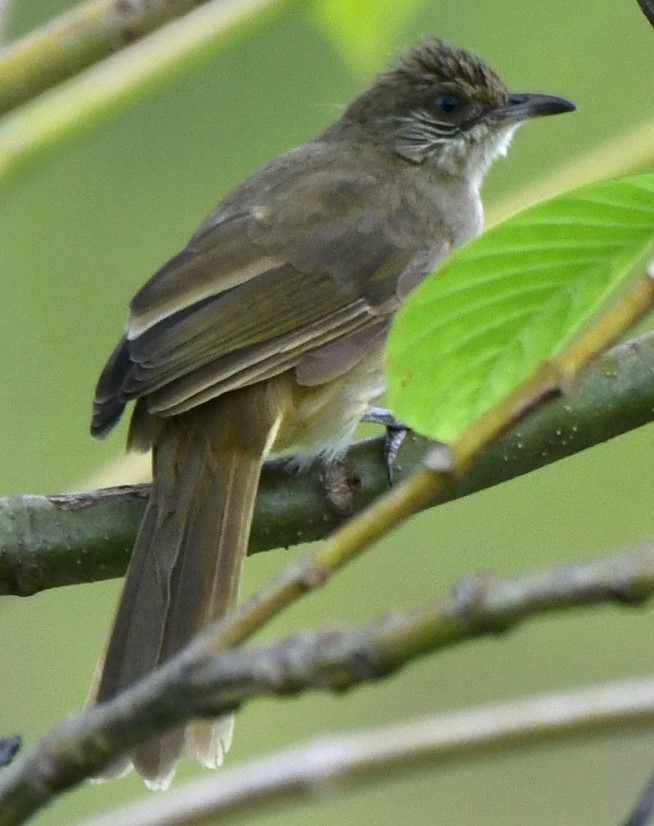
- Yellow-bellied Warbler Abroscopus superciliaris 1 vocal, in mid-level at edge of broad leaf forest, R, R8E
- Sooty Babbler Stachyris herberti 8 vocal, greg. active in understory of limestone forest, on rocks, on staircase and low in trees, C, RVP (photo)
- Pin-striped Tit-babbler Mixornis gularis 2 vocal, active in forest below observation deck, C, RVP
- Golden Babbler Cyanoderma chrysaeum 1 vocal, roadside forest clearing, R, NHV
- Common Myna Acridotheres tristis 3 on grass in water department yard, C, NHV
- Great Myna Acridotheres grandis 3 greg. on ground in pasture, flying over resort garden and farm, UC, NHV
- Oriental Magpie Robin Copsychus saularis 1 edge of farm, UC, NHV
- White-rumped Shama Kittacincla malabarica 1 flew low across road and into adjacent forest, R, R8E
- Yellow-billed Whistling Thrush Myophorus flavirostris 1 on distant limestone outcrop in a forest clearing below the observation deck, R, RVP
- Pied Bushchat Saxicola caprata 2 (m,f) a pair sallying to ground for insects, in roadside wetland and on farm fence lines, C, NHV
- Blue-winged Leafbird Chloropsis moluccensis 2 (m,f) a pair ig in canopy of broad-leaf trees in roadside karst forest, R, RVP
- Olive-backed Sunbird Cinnyris jugularis 2 (m,f) pairs foraging at lower to mid-level in broadleaf forest edge and second-growth, UC, NHV
- Greater Crimson Sunbird Aethopyga seheriae 2 (m,f) foraging in flowering shrubs and trees, gardens and forest edge, UC, NHV
- Scaly-breasted Munia Lonchura nisoria 20 ad, imm., vocal, gregarious, foraging on seeds in tall grass and shrubs, C, ubiq.
- House Sparrow Passer domesticus 4 (m,f) pairs foraging on open ground, often loosely associated with EUTS, C, NHV
- Eurasian Tree Sparrow Passer montanus 50 (m,f) vocal, greg., foraging on ground in pasture, towns, villages and most other modified habitats, C, ubiq.
- Paddyfield Pipit Anthus rufulus 5 individuals on the ground in a variety of short-grass wetlands, C, NHV
___________________________________________________________
